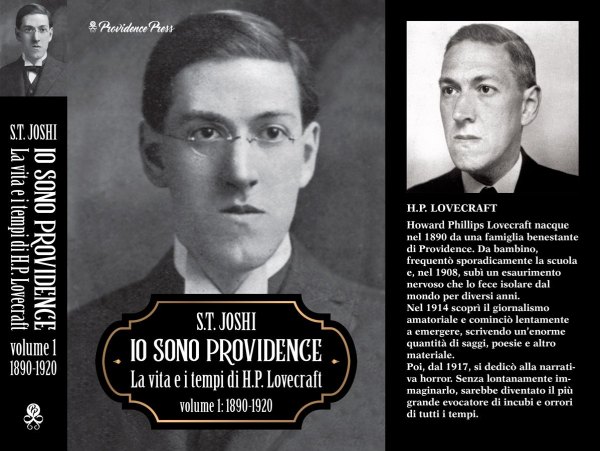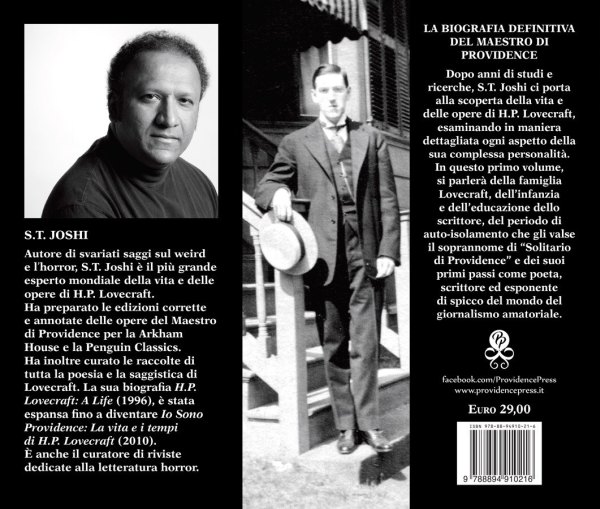S. T. Joshi&’s Blog from 2019
December 11, 2019 — New Books from Hippocampus Press
I am in receipt of several new titles from Hippocampus Press, and have a small number of spare copies to offer to interested readers at a slight discount from the retail price:
- H. P. Lovecraft, Letters with Donald and Howard Wandrei and to Emil Petaja ($25)
- T. E. D. Klein, Providence After Dark and Other Writings ($25)
- Robert H. Waugh, The Tragic Thread in Science Fiction ($15)
In addition, I have copies of Dead Reckonings No. 26 (Fall 2019), in which I have two reviews (one a joint review of a revised version of Mike Ashley’s biography of Algernon Blackwood and of William F. Nolan’s Writing as Life; the other a review of Machinations and Mesmerism, edited by Farah Rose Smith, with some brief memories of the late Sam Gafford). I am prepared to offer this for the bargain price of $5 to anyone who purchases any of the above titles.
The Lovecraft volume is a revised version of Mysteries of Time and Spirit (2002), with the addition of the letters to and from Howard Wandrei and the letters to Emil Petaja (the manuscripts of which I recently helped the John Hay Library acquire). The Klein volume is a massive (591 pp.) collection of his essays on all manner of subjects: weird fiction (including his pungent treatise “Dr. Van Helsing’s Handy Guide to Ghost Stories”), film, animal rights, crime, and many other subjects. And Robert H. Waugh’s book is a scintillating analysis of the intersection of fantasy, horror, and science fiction, with chapters on Lovecraft, David Lindsay, Olaf Stapledon, Arthur C. Clarke, Fritz Leiber, and other writers.
I am in receipt of John C. Tibbetts’s The Furies of Marjorie Bowen (https://mcfarlandbooks.com/product/the-furies-of-marjorie-bowen/), a fascinating treatise on the weird work of this neglected British writer. Tibbetts is compiling a volume of Bowen’s supernatural fiction for Hippocampus Press.
I don’t have much else to report at the moment. But I’d like to pose a query to anyone who might be interested. Some time ago I found a photograph of Ramsey Campbell and some unidentified individual in Wilum Pugmire’s copy of one of Ramsey Campbell’s books. Some of us thought the person in the photo might be Wilum himself, at a much earlier age; but his sister asserts that it is not him. So who could it be? It was presumably taken at a convention where Ramsey appeared. So who is this person, and why did Wilum have this photograph in the first place?
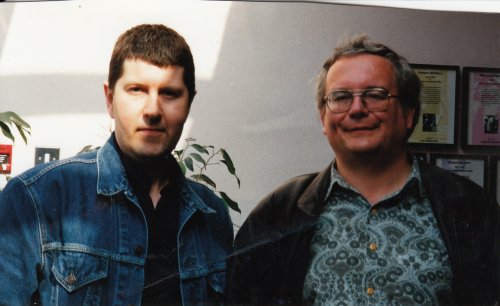
Who is this person with Ramsey Campbell?
November 30, 2019 — Fire Sale!
I am delighted to note that a recent contributor to Spectral Realms, Carl E. Reed, was asked to write a review of the most recent issue (#11, Summer 2019). It is all that a review of this kind could be, and we should all thank Carl for his diligence and perspicacity. Here is the review: https://www.blackgate.com/2019/11/19/terror-existential-dread-and-surprised-laughter-a-review-of-spectral-realms-11/.
French scholar Gilles Menegaldo, one of several figures whom I met during my trip to France in May, is now seeking funding for his planned documentary of Lovecraft (for which he has interviewed me), entitled Le Monde du Lovecraft (The World of Lovecraft). He is seeking to raise 30,000 euros for this 60-minute film. I have high confidence in Gilles’s ability to produce a worthy product, so his project should certainly be generously supported. Here is a link to the crowdfunding site: https://www.ulule.com/le-monde-de-lovecraft/.
Finally, I trust that those who live in the Seattle area will want to partake of one or both of my upcoming choir concerts, on December 7 and 14. They will feature an entertaining mix of old and new Christmas songs: http://www.nwchorale.org/concerts.php. You will also note that we are holding our annual “Messiah Sing-along” on December 28; and, now that Mary has bought me a spanking new bow for my violin, I am threatening to play the first violin part (as I did in 2014) rather than singing!
As has become customary, I am holding a fire sale of books that have been sitting around here for a while, and which I would like to get rid of. So let me say that each of the following books can be obtained for $10.00—and please note that in some cases I have only a single spare copy available:
- Leigh Blackmore, Spores from Sharnoth and Other Madnesses (P’rea Press, 2013)
- James Chambers et al., ed., A New York State of Fright (Hippocampus Press, 2018)
- Théophile Gautier, The Mummy’s Foot (Hippocampus Press, 2018)
- Shirley Jackson, The Haunting of Hill House (Penguin, 2013)
- S. T. Joshi, Emperors of Dreams (P’rea Press, 2008)
- S. T. Joshi, The Original Atheists (Prometheus Books, 2014)
- S. T. Joshi, 21st-Century Horror (Sarnath Press, 2018)
- S. T. Joshi, ed., Dissecting Cthulhu (Miskatonic River Press, 2011)
- S. T. Joshi and Lynne Jamneck, ed., Gothic Lovecraft (Cycatrix Press, 2016) [trade hardcover] [signed/limited hardcover available for $25]
- S. T. Joshi and David E. Schultz, Lovecraft’s Library: A Catalogue (4th ed., Hippocampus Press, 2017)
- Josh Kent, The Witch at Sparrow Creek (Hippocampus Press, 2015)
- Curtis M. Lawson, Black Heart Boys’ Choir (Wyrd Horror, 2019)
- Charles Lovecraft, ed., Avatars of Wizardry (P’rea Press, 2012)
- H. P. Lovecraft, The H. P. Lovecraft Cat Book (Necronomicon Press, 2019)
- H. P. Lovecraft, Lord of a Visible World: An Autobiography in Letters (Hippocampus Press, 2019)
- H. P. Lovecraft, Selected Essays (Necronomicon Press, 2019)
- H. P. Lovecraft, To a Dreamer: Best Poems of H. P. Lovecraft (Necronomicon Press, 2019)
- H. P. Lovecraft, Conto la religione (Nessun Dogma, 2018)
- Richard A. Lupoff, Dreams (Hippocampus Press, 2012)
- Richard A. Lupoff, Visions (Hippocampus Press, 2012)
- D. L. Myers, Oracles from the Black Pool (Hippocampus Press, 2019)
- E. Nesbit, From the Dead (Hippocampus Press, 2018)
- William F. Nolan, Nolan on Bradbury (Hippocampus Press, 2013)
- Fred Phillips, From the Cauldron (Hippocampus Press, 2010)
- Edgar Allan Poe, The Raven: Tales and Poems (Penguin, 2013)
- W. H. Pugmire, An Imp of Aether (Hippocampus Press, 2019)
- Joseph S. Pulver, Sr., Sin & Ashes (Hippocampus Press, 2010)
- Ann K. Schwader, Twisted in Dream (Hippocampus Press, 2011)
- Mary Shelley, Frankenstein (Penguin, 2013)
- Mary Shelley, Frankenstein and Others (Hippocampus Press, 2018)
- Donald Sidney-Fryer, The Atlantis Fragments: The Novel (Hippocampus Press, 2011)
I also have available a few slightly more expensive items for sale:
- S. T. Joshi, An Index to the Selected Letters of H. P. Lovecraft (Necronomicon Press, 1980) [$60]
- S. T. Joshi and Marc A. Michaud, ed., H. P. Lovecraft in “The Eyrie” (Necronomicon Press, 1979) [$75]
- S. T. Joshi and Marc A. Michaud, Lovecraft’s Library: A Catalogue (Necronomicon Press, 1980) [$40]
- H. P. Lovecraft, Uncollected Prose and Poetry (Necronomicon Press, 1978) [$60]
- H. P. Lovecraft, Uncollected Prose and Poetry 3 (Necronomicon Press, 1982) [$40]
- Arthur Machen, Collected Fiction (Hippocampus Press, 2019; 3 vols.) [$75]
- S. T. Joshi, H. P. Lovecraft: A Life (Necronomicon Press, 1996) [signed hardcover] [$300]
Finally, I will offer the following items for $5.00 to anyone who purchases any of the above titles. But please note that only a small number of copies of some of these items are available:
- Lovecraft Annual No. 5 (2011)
- Lovecraft Annual No. 11 (2017)
- Lovecraft Annual No. 12 (2018)
- Lovecraft Annual No. 13 (2019)
- Spectral Realms No. 8 (Winter 2018)
- Spectral Realms No. 9 (Summer 2019)
- Spectral Realms No. 10 (Winter 2019)
November 15, 2019 — Yet More Books
Before I get to the main topic of this blog, I would like to remind readers of the 25% discount I am offering for all books priced at $10 or more in Wilum Pugmire’s library. There are still a lot of choice items available, so don’t delay in ordering any that you like!
As for me, I have just had two books published—my novella Something from Below and my anthology Best of Black Wings. The former is in hardcover and the latter in softcover; both were published by PS Publishing last month. The former is priced at £18 and the latter at £14.99. I have an abundance of copies here for interested customers, and would be happy to let the first one go at $20 and the latter at $15, on the usual terms (i.e., no extra postage for US customers).
I also have exactly one spare copy of the first volume of the Italian translation of I Am Providence, entitled Io sono Providence (http://www.providencepress.it/it/io-sono-providence-la-biografia-di-h-p-lovecraft/). I see that the book is priced at 29 euros, so I will be happy to dispose of this copy for $25 if anyone is interested. This is the first of a three-volume set! I have no idea when the other two volumes will appear.
My long quest to disseminate Lovecraft’s letters—and to champion their value both as documentary evidence for aspects of Lovecraft’s life and work and as literary works in themselves—has borne fruit in an interesting way. The H. P. Lovecraft Historical Society has now begun a podcast in which extracts of important or interesting letters by Lovecraft are read. You can subscribe here: http://www.hplhs.org/voluminous.php. This is a most worthy undertaking, and I myself have recently made a suggestion as to a particular letter that I would like read.
Otherwise, work proceeds on the usual multiple fronts. I am assembling a volume of Machen’s autobiographical writings (his three formal autobiographies—Far Off Things, Things Near and Far, and The London Adventure, augmented by a few separate essays), as a kind of supplement to my recent edition of Machen’s Collected Fiction. (I may mention that one copy of this 3-volume set is still available here, and I am prepared to part with it for $75.) My publication of H. L. Mencken’s Collected Essays and Journalism has reached 22 volumes, and I am now about to begin the publication of his 1200 “Free Lance” columns of 1911–15, which may extend to as many as 12 volumes.
The Hippocampus edition of Lovecraft’s letters to Donald and Howard Wandrei (also including the letters to Emil Petaja) is nearly ready and should be out in a few weeks. Upcoming are the huge volume of Lovecraft’s Letters to Family and Family Friends (the bulk of which consists of his letters to his aunts), a volume of his letters to E. Hoffmann Price and Richard F. Searight, and new editions of the letters to Alfred Galpin and Rheinhart Kleiner, each augmented with letters to several other individuals.
A volume of the letters of Clark Ashton Smith and August Derleth is almost ready to go, and it will be supplemented next year with a volume of letters between Smith and Samuel Loveman—a particularly interesting compilation that sheds much light on their readings of weird poetry. We have also prepared a new edition of Loveman’s Out of the Immortal Night (2004)—a volume that we thought had included the bulk of his work, but which has now been augmented with a number of additional pieces, along with a long interview of Loveman conducted by a colleague in the 1960s. The book now exceeds 400 pages! On a related front, we are very close to issuing the mammoth Leah Bodine Drake omnibus (The Song of the Sun), but this will probably not emerge until early next year.
Another incredibly worthy project is Fantastic Fictioneers, a lavish two-volume reference work, chock full of illustrations and other interesting matter, dealing with hundreds of leading authors, artists, filmmakers, and other important figures in weird fiction. The book has been published by PS Publishing, but copies are available at a bargain price from the editor, Pete Von Sholly (https://www.ebay.com/itm/254421559323). I wrote four or five entries in the work.
I have recently gotten in touch with Martin Swanson, a veteran collector of Arkham House books (some of which he obtained directly from August Derleth) who wishes to sell some of these items. Here is a list of what he is offering:
Books by H. P. Lovecraft:
- The Shunned House
- Something about Cats and Other Pieces
- Selected Letters, Volumes 1 and 2
- Dagon and Other Macabre Tales
- The Dunwich Horror and Others
- The Shuttered Room and Other Pieces
- At the Mountains of Madness and Other Novels
- Dreams and Fancies
Books by Others
- Zealia Bishop, The Curse of Yig
- Ramsey Campbell, The Inhabitant of the Lake
- August Derleth, Dark Mind, Dark Heart
- August Derleth, The Mask of Cthulhu
- August Derleth, The Trail of Cthulhu
- August Derleth, Travellers By Night
- August Derleth, The Survivor and Others
- Robert E. Howard, The Dark Man and Others
- Frank Belknap Long, The Horror from the Hills
- Clark Ashton Smith, Selected Poems
- Clark Ashton Smith, Genius Loci
- H. Russell Wakefield, The Clock Strokes 12
- Donald Wandrei, The Web of Easter Island
- Colin Wilson, The Mind Parasites
Non-Arkham House Books:
- Mirage on Lovecraft
- Mark Owings, The Necronomicon: A Study
- Lovecraft, The Dream-Quest of Unknown Kadath (Shroud, 1955)
- Robert E. Howard, Red Shadows (Donald M. Grant, 1968)
Those who are interested in any of these titles should let me know, and I will put you in direct touch with Swanson.
November 1, 2019 — 25% Off on Wilum’s Books!
Before I get to the main subject of this blog, I would like to announce the (self-)publication of a revised version of my critical study of Lord Dunsany, published in 1995 as Lord Dunsany: Master of the Anglo-Irish Imagination and now titled Creator of Gods and Men: Lord Dunsany and Fantasy Fiction (https://www.amazon.com/Creator-Gods-Men-Dunsany-Fantasy-ebook/dp/B07ZG5G9GJ/). In this new version, I discuss works by Dunsany published subsequent to my original study, including my own editions of The Pleasures of a Futuroscope (2007) and The Ghost in the Corner (2017). Overall, I frankly think this book is the most penetrating critical study I have ever written, with the possible exception of H. P. Lovecraft: The Decline of the West (1990).
And I can announce that I have now officially published 300 books—the 300th title being, somewhat anticlimactically, the twenty-first volume of my ongoing series, Collected Essays and Journalism of H. L. Mencken. I calculate the “publication” of a book depending on when I actually receive copies, although that is not always an accurate gauge. I am aware that two of my books—my novella Something from Below and the anthology Best of Black Wings—are out from PS Publishing, but copies have not drifted over here from the UK. I think that my treatise Varieties of Crime Fiction is imminent from Wildside Press, but again I don’t have copies yet. And at least one further volume of Lovecraft letters—Letters with Donald and Howard Wandrei and to Emil Petaja—is soon to appear from Hippocampus Press.
Early next year I will publish 300 Books by S. T. Joshi (a revision, of course, of 200 Books by S. T. Joshi, published only five years ago), as well as a substantial compilation of the interviews I have given over the decades (along with a few autobiographical essays). After getting these excursions into immodesty out of the way, I will resume real work.
But the subject of the day is my announcement of a sale on Wilum’s library. All items costing $10 or more will be discounted 25% for the entire month of November. The updated website (http://sesqua.net/pugmire-book-sale.html) now lists his books on general literature, general poetry, and Oscar Wilde. Lots of tempting items here! And I hope that certain of the more expensive items that have yet to be claimed will now become more appealing as a result of the discount. So come and get ’em!
October 17, 2019 — The H. P. Lovecraft Film Festival
I was happy to attend the H. P. Lovecraft Film Festival in Portland, Oregon (October 4–6), where I met several friends old and new. Mary and I went down on Thursday, October 3, as there was a book launch of D. L. Myers’s new Hippocampus Press poetry collection Oracles from the Black Pool at the Book Bin of Salem. This event was well attended, and not only Myers, but other members of the Crimson Circle—Adam Bolivar, Ashley Dioses, and K. A. Opperman—were present, and each of them read selections from their weird verse. I am now in possession of additional copies of Myers’s book and am prepared to let it go for the discounted price of $10 (which includes postage within the U.S.) through the month of October. I am prepared to make the same offer for Curtis M. Lawson’s fine short novel Black Heart Boys’ Choir.
The Book Bin’s proprietor, Obadiah Baird, presented me with the latest issues (nos. 7 and 8) of his splendid fanzine, The Audient Void. This zine presents a fine mix of fiction, poetry, artwork, and columns, including one by David Barker, “Ye Olde Lemurian.” The column in issue 8 is an extended account of his collaborations with W. H. Pugmire. Barker and his wife were in the audience at the Book Bin, and we enjoyed renewing our acquaintance with them. There is no actual website for the zine, but feel free to inquire with Obadiah at: TheAudientVoidMag@gmail.com.
The highlight of the festival itself, of course, was the showing of Richard Stanley’s new adaptation of “The Colour out of Space,” entitled Color [sic] out of Space. It is a splendid adaptation that takes relatively modest liberties with the original text, chiefly in setting it in the present day, in having much of the action focus around a teenage daughter of Nahum Gardner, and in having the role of the story’s narrator (the surveyor for the new reservoir) played by a young and attractive African American. (There is, in essence, no character in the film corresponding to Ammi Pierce.) Nicolas Cage, of course, stars as Nahum Gardner, and his wife is ably played by Joely Richardson. Some of the special effects are spectacular, and the film develops a fine sense of cumulative horror as it builds to a powerful climax.
I had the privilege of speaking with Richard Stanley after the first showing of the film at the festival, and we chatted about various things—specifically, how he was forced to use the American spelling of “color” in the title (and also to drop the “the”), for reasons having largely to do with marketing. The film will be commercially released in January, and I will be interested to gauge its response among audiences and critics.
Otherwise, there was a very interesting Swedish adaptation of “The Outsider” and some other worthy films. Mary and I attended Jason and Sunni Brock’s party on Saturday night at their house, and were glad to meet Jason’s mother, who was visiting; the Barkers also put in an appearance. William F. Nolan, however, had taken suddenly ill with some respiratory problems, but we visited him in the hospital the next day on our way home. I believe he himself is now back at his assisted living facility, not much the worse for wear. The coming issue of Dead Reckonings will feature my review of Bill’s collection of essays, Literature as Life (along with a review of the new and expanded version of Mike Ashley’s biography of Algernon Blackwood).
Another fine book that has drifted this way is Kyla Lee Ward’s superb new collection of poetry, The Macabre Modern, just out from P’rea Press (http://www.preapress.com/books.php?isbn=9780994390127). It can be seen that the book is available in both a paperback and a hardcover edition, both of which are highly attractive. I wrote an afterword to the book. Ward is, with Ann K. Schwader, Wade German, and the Crimson Circle poets, among the leading exponents of weird poetry in our time. I was tremendously glad to have met her, albeit briefly, during my Australian trip of last June/July.
My novella Something from Below will apparently debut at FantasyCon in Glasgow (October 18–20), but an advance review of it from Gary Fry has already appeared: https://garyfrytalks.blogspot.com/2019/10/something-from-below-by-s-t-joshi-review.html. Many thanks to Gary for his perceptive and generous review!
I have now entered additional items into the catalogue of Wilum Pugmire’s library, including his holdings of magazines and some rare pamphlets from Necronomicon Press and others. Among his magazines are such things as Lovecraft Studies, Lovecraft Annual, Weird Fiction Review, Studies in Weird Fiction, Nyctalops. and two magazines from the 1980s edited by Jessica Amanda Salmonson, Fantasy Macabre and Fantasy & Terror. There are also a number of tempting booklets and pamphlets issued by Necronomicon Press and other small-press publishers. Here’s a link to the updated listing: http://sesqua.net/pugmire-book-sale.html.
October 2, 2019 — Books by Hippocampus Press—and Others
I am at last in receipt of additional books from Hippocampus Press that emerged around the time of the NecronomiCon, more than a month ago. I have about 4 copies of each title available for purchase at the following prices:
- Arthur Machen, Complete Fiction (3 vols.) ($75)
- Mark Valentine and Timothy J. Jarvis (ed.), The Scarlet Ceremonies: Critical Essays on Arthur Machen ($20)
- H. P. Lovecraft, Letters to Wilfred B. Talman and Helen V. and Genevieve Sully ($20)
- D. L. Myers, Otacles from the Black Pool ($10)
I am also pleased to note that several other books that have long been in production seem finally on the brink of emerging. I recently read final proofs of my monograph Varieties of Crime Fiction (Wildside Press) and hope to see the volume emerge soon. Two of my books from PS Publishing, the anthology The Best of Black Wings and my weird novella Something from Below, should appear for FantasyCon, to be held in Glasglow on October 18–20. Two other PS books, my critical study Ramsey Campbell: Master of Weird Fiction (an extensively revised version of Ramsey Campbell and Modern Horror Fiction [Liverpool University Press, 2001]) and the anthology Apostles of the Weird, should appear for StokerCon (Scarborough, UK, April 16–19, 2020).
Speaking of books, I am in receipt of a multitude of copies of Curtis M. Lawson’s superb short novel Black Heart Boys’ Choir (https://www.amazon.com/Black-Heart-Choir-Curtis-Lawson/dp/1075108063/ ). I wrote the foreword to this gripping novel, which not only probes the weird overtones (pardon the pun) of music but provides a searing account of the social and personal traumas of high school life. I will be happy to let my copies go for $15. Lawson is one of the rising stars in our field, and in my judgment this is a breakout book for him.
A more established author, Nicole Cushing, has published a new novel, A Sick Gray Laugh (https://www.amazon.com/Sick-Gray-Laugh-Nicole-Cushing/dp/B07W74Y1XY/ ). I copyedited the book for the author, and she acknowledges my assistance in a brief note at the end of the book (although referring to my work as “assistance with pre-submission proofreading”).
Jason Ray Carney has published what looks to be an interesting study, Weird Tales of Modernity (https://mcfarlandbooks.com/product/weird-tales-of-modernity/), focusing on Robert E. Howard, Clark Ashton Smith, and H. P. Lovecraft and their contributions to Weird Tales. Carney published what might have been an abstract of this book in an essay in The Unique Legacy of Weird Tales, edited by Justin Everett and Jeffrey H. Shanks (Rowman & Littlefield, 2015), part of the series “Studies in Supernatural Literature” that I edited for the publisher.
On an entirely different and charming note, I have come into contact with a woman named Dorothea, who purchased some books from Wilum Pugmire’s library. In the course of discussions with her on various subjects, in particular my various musical compositions (including my setting of Lovecraft’s “Little Sam Perkins”), she related to me the following delightful anecdote:
“Being a cat lover all my life, I have a special fondness for Sam Perkins and, what I consider, a coincidental relationship with his echo. When I was planning my first HPL road trip to New England back in 2017, Sam Perkins was my mascot and I made numerous T-shirts and postcards featuring black cats. I was going to travel independently for over a month and, just before I left, the whole prospect started to seem quite daunting. To calm my nerves, I ‘drove’ through College Hill in Providence using Google Maps and my last stop was Prospect Terrace. Much to my delight, an image of the park revealed a small black cat staring at the camera. It sounds silly, but the coincidence boosted my confidence. Later, while savoring several glorious sunsets at the park, my thoughts would return to the little black cat. One evening, I left the crowd at the park and walked down Congdon Street to a small grassy square which offers a good view of the First Baptist Church. No people were there, but I quickly spotted my black cat! Without thinking I blurted out, ‘There you are.’ And he quickly ran in my direction as if I was his long-lost friend. My heart skipped a beat. It was obvious that he was alert to all the human and vehicular traffic and wary of it. But with me he didn’t hesitate to roll on the ground and take a brief bath, etc. He was completely relaxed. We then sat by the primroses and watched the sunset together. When he had the sudden urge to chase a bug, I took the opportunity to slip away without a backward glance. I was afraid that might otherwise draw him toward the busy street. I’ll never forget the encounter. What a coincidence!”
Dorothea managed to take a picture of the “little imp of the night”:
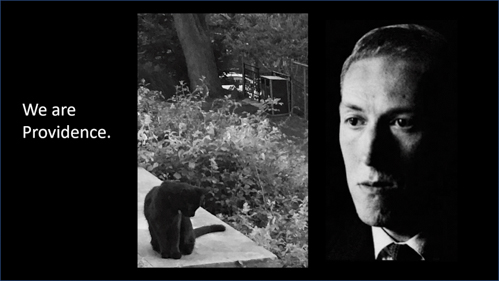
Dorothea’s Black Cat of Providence
Speaking of Wilum’s library: I have now catalogued his extensive collection of magazines and fanzines, which includes extensive runs of Lovecraft Studies, Studies in Weird Fiction, Fantasy & Terror, Fantasy Macabre, Weird Fiction Review, and other tempting items. Watch for an update to the website soon!
September 15, 2019 — A Trip to the Midwest
Four days after I came back from the East Coast (in the company of that Canadian film crew shooting a documentary on Lovecraft), I boarded what might be my 21st plane of the year (!) for an actual vacation—a trip to Minnesota to see some of Mary’s relatives, and then a long weekend in Chicago. The visit was most pleasant, and allowed me to chill out after a grueling summer. I did no work on the trip—except for some pleasant “work” that I will mention later.
We arrived in the Twin Cities on Saturday, August 24, staying with Mary’s sister Katie and her husband Arnis (Arnie) Kurmis. They generously put us up for five nights while we went here and there, both for family events and other outings. The chief reason for going was to see another of Mary’s sisters, Carol, who had just married a charming woman named Stacy, whom most of us were meeting for the first time. On Sunday afternoon there was a lavish reception for them at the home of Mary’s mother, Nancy Krawczak, and a good time was had by all.
On subsequent days, Katie’s daughter Emily (who has taken several photos of me that appear on this website as well as on the jackets of some of my books) dropped by for dinner; we visited Mary’s longtime friend Amy Lundgren (whom she has known since the age of twelve) and her husband Bruce; and we ate in various restaurants in the area, either by ourselves or with others.
On August 28 I was happy to appear at DreamHaven Books, one of the nation’s leading bookstores for fantasy, horror, and science fiction books. I talked generally about my involvement with Lovecraft, focusing on my editing of Lovecraft’s letters. Joining me was D. H. (Dwayne) Olson, the Wandrei authority, who had a number of his own editions of Wandrei’s books (as published by Fedogan & Bremer) available for purchase. The crowd was modest in numbers but highly engaged, and we discussed various matters for two hours or more before Dwayne, Mary, and I had dinner in a local restaurant.
On Thursday, August 29, we headed to Chicago—but stopped about halfway, at the well-known resort known as the Wisconsin Dells. This idyllic rustic venue (sadly littered with an array of cheap establishments catering to the unwashed) was a welcome interim stop, and would contrast sharply with the immense bustle of the metropolis where we were headed. We took a two-hour boat trip that showed us the fascinating rock formations of the area.
There were not one, not two, but three mini-golf places that looked mighty tempting, but my tyrannical wife would not let me play on any of them, as we had to leave by early afternoon the next day in order to avoid rush-hour traffic in Chicago. As it happened, we ended up getting stuck in traffic anyway (chiefly as a result of the perennial road construction in the Chicago area), and then had some difficulty returning our rental car; but with that accomplished, we could look forward to getting reacquainted with this megalopolis, which I had probably not visited since (if recollection serves me) the 1990 World Fantasy Convention.
Over the next two days we thoroughly explored both the Art Institute of Chicago and the Field Museum (natural history), becoming so exhausted after each visit that we had to retreat to our hotel for long naps before dinner. We were staying in the Hilton Garden Inn, on the corner of Grand and State Streets, right in the heart of Chicago. We also walked to the shore of Lake Michigan and did part of the “Riverwalk” along the Chicago River.
But the highlight of the trip was, of course, our visit to historic Wrigley Field on Labor Day to watch the Chicago Cubs play (of all teams) the Seattle Mariners! This matchup was purely fortuitous, and I richly enjoyed the Cubs’ defeat of the Mariners by the score of 5–1. The result was the more satisfying because, in the past two or three games, the Cubs had gone about 26 innings without scoring a run—quite an achievement! Toward the end of the game the crowd in the center field bleachers (where we were) became so giddy at the impending victory that even the players looked up at us in bemusement. Here is a picture of me standing near the celebrated sign on the front of the building:
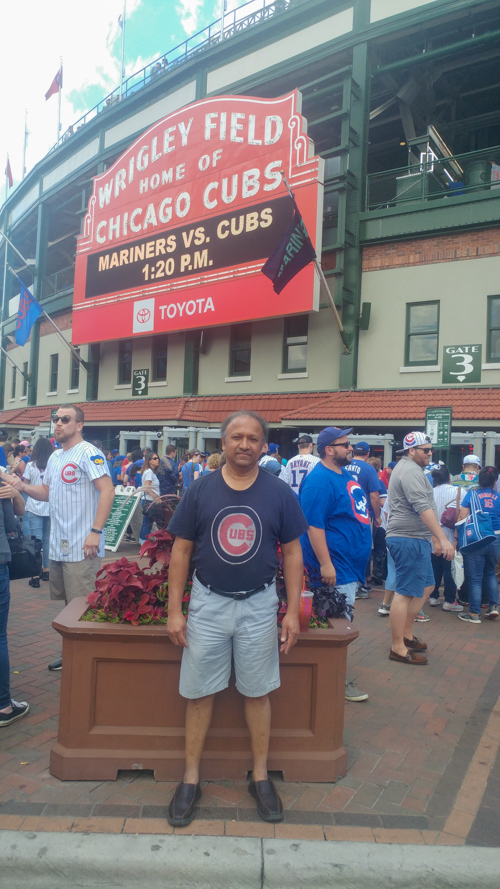
S. T. at Wrigley Field
As I say, I did no real work—except for the composition of four choral pieces. One or two were done on plane rides, others were done at Katie’s house during random moments. I have now set these poems to music:
- “Ecstasy” (Clark Ashton Smith)
- “Ever of You” (George Sterling)
- “Poplars” (Clark Ashton Smith)
- “To Science” (George Sterling)
That last piece (Sterling’s great atheistic sonnet, referring to a world “Still haunted by the monstrous ghost of God”) is not quite finished; and in any case it will take me some time to transcribe all these pieces in the music notation software I am using. But this gives me a total of twelve compositions, which may run to as much as 50 or 60 minutes. Enough for a CD!
The posting of a revised list of books for sale from Wilum Pugmire’s library was somewhat delayed, but is now ready. Here is the link: http://sesqua.net/pugmire-book-sale.html. Come and get ’em!
August 22, 2019 — A Trip to Lovecraft Country
Before I get to my most recent travels, I wish to note with pleasure the arrival of a sheaf of new (or not so new) Hippocampus Press books. The following are now here (with discounted prices affixed):
- Lovecraft Annual No. 13 (2019) ($10.00)
- Donald Sidney-Fryer, West of Wherevermore and Other Essays ($15.00)
- W. H. Pugmire, An Imp of Aether ($15.00)
- Bobby Derie, Weird Talers: Essays on Robert E. Howard and Others ($15.00)
- Matt Cardin, To Rouse Leviathan ($15.00)
- Dennis P. Quinn, ed., Lovecraftian Proceedings 3 ($15.00)
- H. P. Lovecraft, Lord of a Visible World: An Autobiography in Letters ($20.00)
In most cases I only have a few copies of these items, so order soon! (That said, I will not be able to fill orders until I return from my next trip—to Minnesota and Chicago, August 24–September 3.)
I also received copies of Spectral Realms No. 11 (Summer 2019) and Dead Reckonings No. 25 (Spring 2019). I am prepared to make a unique offer: to purchasers of any of the titles above, I will add one or both of these magazines at only $5.00 each.
And I can make an even more distinctive offer. I have just received copies of a CD of selections from my choir’s recent performance—which includes my own piece, “Sunset” (based on the Lovecraft poem), along with works by Bach, Bruckner, Brahms, and others. Those who are interested in this item can have it for $10.00—or $5.00 with the purchase of any of the titles above (exclusive of the two magazines). Needless to say, this is the first recording of any of my own compositions.
Now for the trip. I flew into New York on August 13, arriving late in the evening and meeting the director of the Lovecraft documentary, Qais Pasha, with whom I have been working for more than a year. Qais has recently received funds from the Canadian government to expand the documentary well beyond merely a focus on Lovecraft’s visits to Quebec, and we decided to cover as many important sites in the Northeast as we could. Over the next two days we visited 259 Parkside Avenue, 169 Clinton Street, the waterfront at Red Hook, 395 East 16th Street (where HPL stayed for a few weeks in the spring of 1928), and other spots in Brooklyn; 317 West 14th Street (where “Cool Air” is set), 93 Perry Street (featured in “He”), and other sites in Manhattan; and we interviewed Peter Cannon at his home in the Upper West Side.
Then, on August 16, we left the New York area to go to central Massachusetts, where we got a fine glimpse of the Quabbin Reservoir and found the elusive Gardner Cemetery (with the striking grave of “Nabby Gardner”) in North Leverett. It is not absolutely certain that Lovecraft came to this spot, but he could have been taken there by W. Paul Cook. We also hit the Bear’s Den, which we know HPL saw, in the company of H. Warner Munn. We ended the day at an Airbnb in a western suburb of Boston.
The next day we visited the North End (Copp’s Hill Burying Ground, Foster Court), then went on to Marblehead, where we were joined by Donovan and Pam Loucks, who led us to the Old Burial Hill and other key sites in that city. Then we went to Salem, where we took in the Charter Street Burying Ground and a few other sites. That night we arrived at the Holiday Inn near the airport in Providence (actually in the suburb of Warwick).
The two days that remained (for me) in Providence were very hectic, as we made an effort to see (and film) a great many sites—the location of 454 Angell Street, 598 Angell Street, 10 Barnes Street, the Fleur-de-Lys Building (the First Baptist Church across the street was, alas, covered in scaffolding), 66 and 140 Prospect Streets, Swan Point Cemetery, Butler Hospital, etc., etc. I did some frenzied research on the Smith/Loveman letters before attending a board meeting (the first I have personally attended in years) of the Friends of the Library of Brown University.
On my last day in Providence, August 20, we interviewed Marc Michaud and Jason Eckhardt (initially at Prospect Terrace; then, when noisy construction activity caused problems, we moved to St. John’s Churchyard). Then, after a hasty lunch, Jason drove me to the airport, and I arrived home late that evening. Qais and his crew are staying a few extra days to do further work in Lovecraft’s native city.
It was a whirlwind trip, and I will not specify the significance of the sites listed above. Suffice it to say that this will be the first documentary to feature these sites, with a discussion of their significance. Qais may get still more funding, with which he hopes to come to Seattle and interview me again and also interview others in the area or in Portland. The documentary will initially be broadcast on the CBC (Canadian Broadcasting Corporation), but a longer version may be prepared for exhibition at festivals or for reproduction as a DVD.
In Salem I was delighted to make personal acquaintance with Curtis M. Lawson, one of my newest protégés:
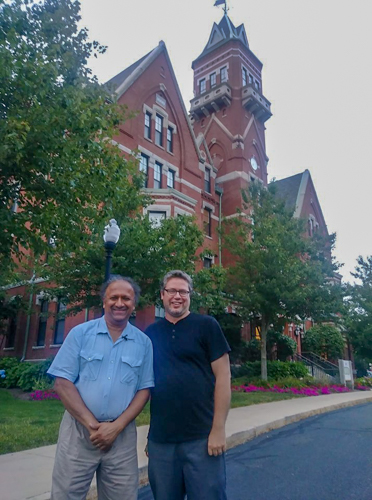
S. T. Joshi and Curtis M. Lawson in front of Danvers State Hospital, which was named in two of Lovecraft‘s works and probably served as the inspiration for his Arkham Asylum.
He is about to release a short novel, The Black Heart Boys’ Choir, for which I wrote an introduction. I will have more to say about this work when it appears.
On both the outgoing and the return trips, I followed my recent pattern of composing choral pieces on airplanes. I have now composed a total of eight pieces (with the names of the authors of the lyrics indicated):
- “Sunset” (H. P. Lovecraft)
- “Continuity” (H. P. Lovecraft)
- “Background” (H. P. Lovecraft)
- “To Helen” (Edgar Allan Poe)
- “My Swan Song” (George Sterling)
- “Little Sam Perkins” (H. P. Lovecraft)
- “Expectancy” (H. P. Lovecraft)
- “Requiescat” (Clark Ashton Smith)
In Providence I was happy to hand over to an official at Brown University a check for $10,000, constituting the initial sum raised by the sale of the library of W. H. Pugmire. The response to the sale has been tremendous; and in a week or two we expect to have still more books posted on the website, including some very choice items indeed. So keep a sharp eye peeled!
August 6, 2019 — The Australia Trip (Part II)
Before I begin my account of the second half of our trip to Australia, I would like to make a momentous announcement: the list of some of Wilum’s books from his personal library is now up and available for purchase! Here is the URL: http://sesqua.net/pugmire-book-sale.html. The list contains what are likely to be the most important and desirable books from his library—i.e., his holdings of Lovecraftiana, general weird fiction, and Arkham House books. I do hope that interested readers will find the list of interest. They should be aware that all the proceeds will be going to a good cause: the purchase of important material (preferably manuscripts) for the H. P. Lovecraft Collection at the John Hay Library.
Now the Australia trip! After the final lecture in Sydney on June 28, Mary and I were taken in hand by Danny and Margaret Lovecraft, who live in a beautiful home in the Lane Cove district of Sydney. Over the next nine or ten days they took us to many of the historical, architectural, and other sites that that magnificent city has to offer—and, of course, we could only sample a fraction of these, for Sydney alone requires weeks to be fully absorbed.
I cannot sufficiently convey the generosity and hospitality of our hosts, whom we found utterly charming, engaging, and considerate. Of course, I had met them at least twice before, on their brief visits to the US, but they went far above and beyond the call of duty in exhibiting to us the beauties of their city and the neighbouring area, and also in preparing tasty meals for us at their home. Here is a nice picture of them:

Margaret and Danny Lovecraft on a Sydney train
Danny was tireless and skilled in driving us to various sites. I will not engage in a chronological accout, but give a more impressionistic narrative of our voyages. I was particularly enraptured by the two wildlife sanctuaries we visited: the Featherdale Wildlife Zoo and the Australian Reptile Park. It was at the former place that I had a photograph taken of me with my head inserted into the jaws of a life-size model of a crocodile:
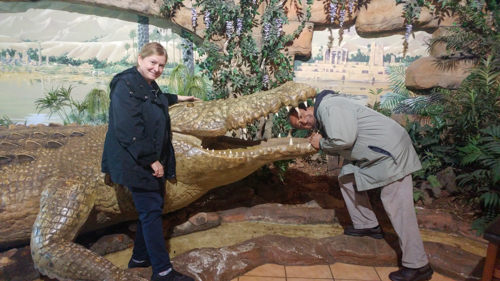
Mary and S. T. with a crocodile at Featherdale Wildlife Zoo
What particularly astonished me—aside from the expected array of kangaroos (one of whom I fed), wallabies, koala bears, Tasmanian Devils, and other indigenous species—was the extraordinary beauty and diversity of the bird life. Cockatoos, lorikeets, and other vivid and colourful birds were on display at both sites; many of them are either rare or not found at all in the US. At one of the wildlife parks we paid extra to have a picture of us taken with a koala bear (who was preoccupied with eating):
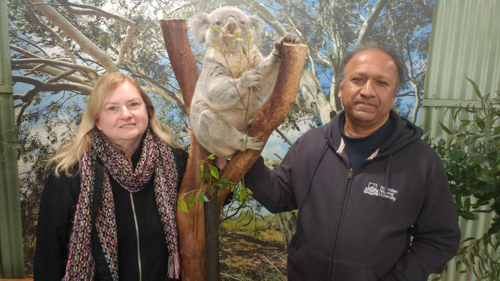
Mary and S. T. with a koala at Featherdale Wildlife Zoo
We also took in some nice concerts—one at the St. James Anglican Church (where the choir sang Ralph Vaughan Williams’s Mass in G Minor in the course of a service) and at St. Andrew’s Cathedral, where a superb French organist, Thomas Ospital, played a diverse array of pieces, from Bach to Duruflé.
We took in the Norman Lindsay Museum Gallery, located at the home he occupied for many years. Mr. Lindsay was a highly talented artist and illustrator—rather partial, if I may say so, to the portrayal of well-endowed women who dispense with the tedium of wearing clothes. And of course we took in the remarkable Sydney Opera House, one of the true wonders of the modern world. We could not, however, go inside, but the exterior was spectacular enough.
On June 30 we went to Wollongong (a southern suburb of Sydney) to participate in Leigh Blackmore’s sixtieth birthday party. We took him to lunch at a nice restaurant, then retreated to his house, where we met his partners, Margi Curtis and her husband Graham, and also the fine poet Kyla Lee Ward (whom we had first met the previous day, at a one-day conference on speculative fiction at the Writing NSW center in Lilyfield). On that occasion I signed many of Leigh’s copies of my books—which I hope made up for my breaking of not one but two pieces of crockery at the party later that evening!
Danny and I did some specifically Lovecraftian exploration. Hyde Park (mentioned in “The Call of Cthulhu”) is a lovely park right in the heart of the city, and what Lovecraft in the same story calls the “Hyde Park Museum” (now the Australian Museum) is a fascinating natural history museum. I wanted to have a photo of myself taken with my head in the jaws of a life-size reproduction of the skull of a Tyrannosaurus rex, but Mary was nowhere to be found, so the opportunity was missed.
Danny and I also went to the library of MacQuarrie University to look up the Sydney Bulletin, well known to readers of “The Call of Cthulhu.” What was my amazement when I discovered that this was not a newspaper, but a magazine of political, social, and literary commentary, with an abundance of fiction, poetry, and artwork (not a little by Norman Lindsay). In short, this paper could not possibly have printed the news article that Lovecraft quotes in the story. I then consulted a copy of The Call of Cthulhu and Other Weird Stories (Penguin, 1999) to see what sort of a note I had written about this matter. Here is the entire text of my annotation: “The Sydney Bulletin was founded in 1880.” Gawd! It is quite clear that I did no research of any kind on this paper, simply assuming that it was (as Lovecraft himself clearly believed) a newspaper, when it was nothing of the kind. So much for my scholarship!
There is much more I could record, from our pedestrian crossing of the incredible Sydney Harbour Bridge to the many find restaurant meals we had (a fine Japanese restaurant; a vegetarian restaurant called Harvest; etc. etc.) to the engaging movie Yesterday (basically about the Beatles), which we took in on a rainy day. I may mention that Danny and I are remarkably in tune in terms of our tastes and attitudes—on weird fiction and poetry, the Beatles, certain television shows, and other things, not to mention political and social issues. Danny and Margaret’s home is a shrine to all the arts, and is full of paintings, sculptures, books, music, and other material that provides a constant inspiration to the artistic soul.
Extensive as this trip was, it was of course only a small taste of this great country. At some later stage it would be nice to go north to Brisbane, west to Perth, and other locales. (I’m not sure I’d like to go through the Great Sandy Desert, however! It is the site where the climactic scene of “The Shadow out of Time” takes place, but my devotion to Lovecraft does have its limits.) We do hope that we can have a more expanded series of Lovecraftian events on some future occasion, although exactly when that will be is a matter of doubt. But there is no question that I will return to Australia someday.
July 30, 2019 — The Revival of Necronomicon Press
This will be an interim blog posting: I’m not quite up to the task of writing about the second phase of my Australia trip, although Mary (who keeps meticulous diaries of our travels) has passed on a good deal of information about that.
At the moment, I am happy to announce two new titles by Necronomicon Press: my editions of Lovecraft’s Selected Essays (https://necropress.com/h-p-lovecraft-selected-essays/) and To a Dreamer: Best Poems (https://necropress.com/to-a-dreamer-best-poems-of-h-p-lovecraft/). I have long wished to issue both books, as a way of enticing readers who don’t wish to wade through the five-volume Collected Essays or my edition of Lovecraft’s complete poetical works, The Ancient Track. My old edition of Miscellaneous Writings (Arkham House, 1995) actually constituted a pretty good volume of his selected essays, but that book is of course long out of print. I have several paperback copies of both volumes and am prepared to part with them for $15 each.
On a related note, I am delighted to hear that Necronomicon Press will be issuing my little detective novel featuring Lovecraft and Sonia as detectives, Honeymoon in Jail. Sam Gafford had accepted this book as an Ulthar Press project, and the book may in fact be a joint Ulthar Press/Necronomicon Press title.
The signed/limited slipcased hardcover edition of The Red Brain is finally out from Dark Regions Press. But I now see from the publisher’s web page (https://darkregions.com/products/the-red-brain-great-tales-of-the-cthulhu-mythos-edited-by-s-t-joshi?&variant=39854640397) that this edition is already sold out! It is certainly a beautiful-looking book. But the paperback edition continues to be available.
I am now in receipt of a splendid reproduction, by the H. P. Lovecraft Historical Society, of the notes to At the Mountains of Madness that Lovecraft scribbled on an envelope. This reproduction comes in both a standard edition (for a mere $12.50) and a deluxe edition (for $55.00). I was privileged to receive the deluxe edition, where the envelope is set in a “float frame” that allows you to look at either side even if it is mounted on a wall. It is well worth securing, as it constitutes one of the most distinctive pieces of Lovecraftiana in existence. Here is the publisher’s webpage for the item: https://store.hplhs.org/collections/frontpage/products/mountains-of-madness-sketch-replica?variant=29223221428289
I made a whirlwind trip to Providence (July 23–25) to meet with a Japanese TV crew that is filming a segment about Lovecraft. The show in question is a literary program called Dark Side Mystery and deals with “Eastern and Western folklores, mystery, science fiction, and horror fiction,” according to a statement by Ryuji Motoyama, who arranged for my appearance. I spent about two and a half hours with Ryuji and his crew talking about Lovecraft at the John Hay Library. But the show’s director did not speak English, so Ryuji had to translate his questions to me into English, and then translate my responses to those questions back into Japanese! He managed the task supremely well, and I enjoyed the experience tremendously. The show will air sometime in September.
During the brief trip I managed to spend a little time with Jonathan Thomas (who, among other projects, is working on a lengthy novel based on Lovecraft’s notes for a story—which August Derleth wrote up into the mediocre “posthumous collaboration” “The Survivor”) and Donovan Loucks. At one point we drove to Namquit Point (now called Gaspee Point), the site where the British revenue ship Gaspee was sunk by Rhode Island rebels. The name is cited in The Case of Charles Dexter Ward. It is a scenic area, and I managed to take a picture of it on my cell phone. I am not exactly adept at this process, and here is the not very satisfactory result:

Gaspee Point, Rhode Island
In August I will be going to Providence again (as well as New York and various points in Massachusetts) with the Canadian documentarian Qais Pasha and his crew. On that occasion I hope to have much more time in all the locales in question.
July 21, 2019 — The Australia Trip (Part I)
Before I relate some of the highlights of my long trip to Australia (June 19–July 9), I wish to announce the receipt of several copies of W. H. Pugmire’s An Ecstasy of Fear, his second book from Centipede Press. I assembled the volume and wrote an introduction to it. Here is the publisher’s page about the book: http://www.centipedepress.com/horror/ecstasyoffear.html. I believe the signed/limited hardcover is already out of print, but I am still prepared to offer my copies (which are indeed of the signed/limited edition, not the unsigned hardcover that is still available) at the original price of $125.
Now for Australia. Mary and I decided to break up the long flight with a stopover in Hawaii (Honolulu). We didn’t do much there except to stroll along Waikiki Beach and have a few meals. The next day (June 20) we headed off to Australia—but almost didn’t make it when we were informed at the airport that we needed visas! Luckily, we were able to get them on the spot (for a fee), and so we proceeded. I tried to enliven the ten-hour flight by working on my latest musical composition, “Background” (based on the Lovecraft poem). Because we crossed the International Date Line, we ended up arriving in Sydney on the 21st. We immediately had to catch a plane to Canberra, the nation’s capital, where we were met by David Bottrill, the organiser of the series of events in which I was to participate. We had dinner at a Malaysian restaurant with several interesting people, including Ellen Greenham, a professor at Murdoch University (in Perth, on the other, or western, side of the continent).
On Saturday, June 22 (my sixty-first birthday—although maybe not, since it was still June 21 in Seattle!), we were met by Danny Lovecraft and Leigh Blackmore, who had come up from the Sydney area for the day. I’d met Danny only a few years ago, but hadn’t met Leigh since the summer of 1990, when he came to New York prior to attending the H. P. Lovecraft Centennial Conference. We did a tour of the impressive War Memorial in Canberra as well as the Australian National Gallery.
Then came the actual event. It featured the performance of a Necronomicon Suite (for clarinet and piano) composed some years ago by Larry Sitsky, a celebrated Australian composer, now quite old (in his eighties), who was in attendance. Leigh gave a talk about Australian scholarship on Lovecraft over the years; Prof. Greenham spoke about the cosmic quality in Lovecraft’s work (an abstract of her Ph.D. dissertation on Lovecraft—which I hope to read soon and will attempt to help her get published with an academic press in the US). I read a prepared speech (culled from some of my previous writings, especially The Rise, Fall, and Rise of the Cthulhu Mythos) on the significance of the Necronomicon in Lovecraft’s work and how the conception changed over the course of his career. The audience was relatively small but highly appreciative, and afterward the three speakers (and Sitsky himself) participated in a question-and-answer session:
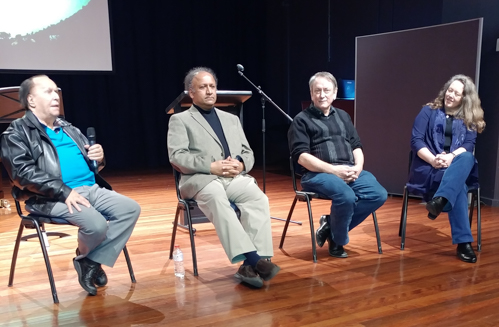
Larry Sitksy, S. T. Joshi, Leigh Blackmore, and Ellen Greenham during Q&A in Canberra
The next day we flew to Melbourne. This is such a large city that we hardly had much time to explore it. On the 24th I gave a radio interview with Elizabeth McCarthy—I’ve forgotten what station this was. That evening I spoke at the second event, going off the cuff this time (very much my preferred way of speaking), telling the incredible tale of Lovecraft’s rise from utter obscurity in his own time to his current worldwide fame (a subject I hope to write a book on, if I can ever find the time). Preceding my talk was one by my old friend Perry Grayson, the Californian who transplanted himself from southern California to Australia more than a decade ago. He spoke fascinatingly on Lovecraft’s influence on rock music, especially the heavy metal music he favours. Mary managed to take a photo of me that made me look almost respectable:
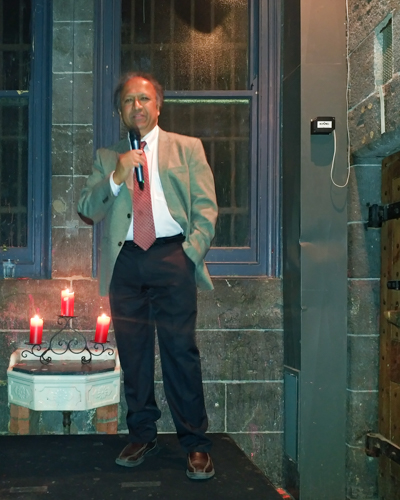
Joshi in Mebourne giving his talk on Lovecraft's rise to fame
On the 25th we flew to Hobart, Tasmania. The next day I gave another radio interview, this time to Rachel Edwards of ABC (Australian Broadcasting Corporation), the nation’s leading public television station. Mary and I also managed to go through a re-creation of the cabins that Sir Douglas Mawson, an Australian explorer, had set up during his ill-fated trip to Antarctica around 1911—an event cited briefly in At the Mountains of Madness.
Surprisingly, the event that evening was the best-attended of any of my four talks. Preceding me were Steve Dillon, a writer and editor who spoke of his involvement with Lovecraft, and Andrew Harper, an engaging fellow who waxed eloquent in his somewhat bluff and informal way about Lovecraft's influence on Saturday morning cartoons. Here I spoke about “Lovecraft and Women”—again off the cuff, but going on at length about Lovecraft’s relations with Sonia and other women (mostly his female correspondents) and talking briefly about the role of women in his fiction. A local bookstore had an abundance of books (mine and others’) for sale.
On the 27th we flew to Sydney. The next morning Danny came by and drove us to Centennial Park, where we had a nice lunch. We later explored the Botanic Gardens and St. Mary’s Cathedral. The event that evening featured Leigh giving an amplified version of his Canberra discussion. Another speaker, Matt Poll of Sydney University, was supposed to speak about the role of aboriginals in Lovecraft’s fiction (especially, of course, “The Shadow out of Time”), but never showed up, and David Bottrill was unable to reach him. Danny came forward to fill the gap by discussing his fascination with Lovecraft and the establishmetn of P’rea Press. On my talk I went on (probably at excessive length) about my own involvement with Lovecraft, from my teenage years to the present day—the subject, of course, of my memoirs, What Is Anything?
All in all, it was a wonderful experience. I can’t say that I exactly sold out the house at each of the venues, but I was always warmly greeted and the other speakers also contributed interesting discussions. All praise must go to David Bottrill, who went far above and beyond the call of duty in arranging these events. Here is a nice picture of him, with me and Mary, at the Royal Melbourne Hotel:
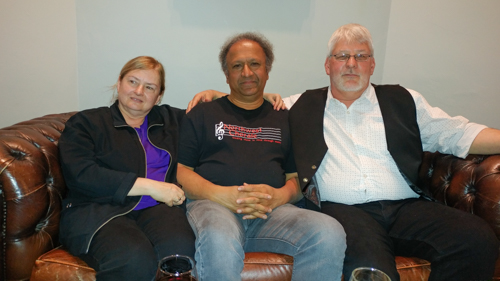
Mary Wilson, S. T. Joshi, and David Bottrill in Sydney
A future blog will tell of our remaining ten or eleven days in Australia, chiefly under the extraordinary hospitality of Danny and Margaret Lovecraft.
I am obliged to end this blog on a sad note. My longtime friend Sam Gafford died on Saturday, July 20, following a massive heart attack. I had known Sam since 1982, when I came in contact with him by correspondence (he was then living in Darien, Connecticut), and he visited me later that year, while I was at Brown University. This began a personal and professional relationship that lasted up to the time of his passing. Lately, Sam had expressed regret that his literary work had not achieved the popularity or critical acclaim it deserted. And yet, his output—consisting of novels (The House of Nodens and Whitechapel), a story collection (The Dreamer in Fire), and his biographical, critical, and bibliographical work on William Hope Hodgson, among other writings—is of substantial merit and distinction.
As a person, Sam was quiet and self-effacing, but he was also a warm and generous man, a loving husband to his wife, Carol, and one who sought to get along with everyone so far as that was possible. He should have no doubts about the merit of his work, for it—and he—will be remembered.
His passing is only the latest in a series of deaths in the Lovecraftian community, including Wilum Pugmire, Stanley C. Sargent, the bookseller Gavin Smith, and Edward P. Berglund. Peace be to all their shades!
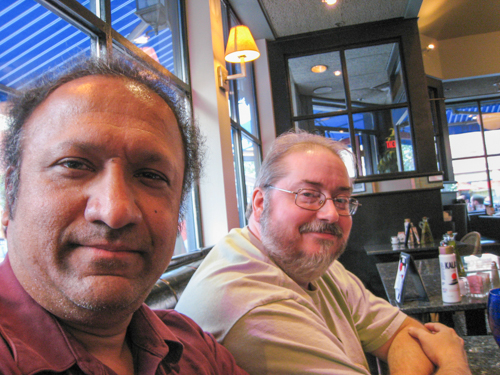
S. T. Joshi and Sam Gafford in 2011
July 14, 2019 — Lovecraftiana and Joshiana
I am not quite prepared to discuss my long trip to Australia (June 19–July 8), so for the time being I will simply note some interesting recent developments in Lovecraftiana—and Joshiana. One of the most interesting is nothing less than a vinyl LP, Selections from “H. P. Lovecraft: A Short Biography,” just issued by Cadabra Records (https://cadabra-records.myshopify.com/collections/frontpage/products/h-p-lovecraft-a-short-biography-written-and-read-by-s-t-joshi-lp-with-music-by-chris-bozzone-yellow-with-black-swirl-vinyl). I edited my 40,000-word text down to about 8000 words and read it myself in two sessions at a local recording studio. I have not actually heard the accompanying music by Chris Bozzone, but I imagine it is quite evocative. I have several spare copies that I am prepared to sell for $25 each (which includes media mail postage in the US).
I have now heard that the first volume of the Italian translation of I Am Providence will now be available in October. I believe Pietro Guarriello is the translator. I see that the cover design for the book has already been prepared:
Frank Rossnagel, the translator of the German edition of the book, informs me that his work on Volume 2 is done and that the book will appear “in a few months.” So then the book will be in French, Italian, and German! The earlier version, H. P. Lovecraft: A Life, has already appeared in a doorstopper of a volume in Polish. A Spanish publisher was contemplating translating I Am Providence, but found the project too big for him; Derrick Hussey is urging the publisher to translate A Dreamer and a Visionary (2001), the truncated edition that I prepared for Liverpool University Press—and which may be reprinted by Hippocampus in the near future.
Vincent Martini has just translated my essay “A Confession of Unfaith” on his website: https://www.terreslovecraftiennes.fr/la-confession-d-un-incroyant. I believe Martini now plans to translate The Case of Charles Dexter Ward.
Another Frenchman, Marc Ang-Cho, has just translated a long interview (which I answered in English via email) into French: https://leschroniquesduchroniqueur.wordpress.com/2019/07/10/interview-de-s-t-joshi/. The English version is also available: https://leschroniquesduchroniqueur.wordpress.com/2019/07/10/an-interview-with-s-t-joshi/. I had spoken briefly with Marc at Les Imaginales.
On another personal note, I may mention that I wrote not one but two musical compositions during my trip, mostly on the long plane rides (to or from Seattle and Honolulu; to or from Honolulu and Sydney). These were “Background” (based on the sonnet in Fungi from Yuggoth) and “My Swan Song” (based on the George Sterling poem that he wrote shortly before his suicide). I had begun “Background” before the trip. I like both compositions, but think “Continuity” is a superior work. Now that I seem to be in the composing mode, I hope to crank out a few more compositions when time permits.
Let me announce here the establishment of a new magazine to be published next summer by Hippocampus Press: Penumbra. This will be an annual magazine, consisting of up to 100,000 words, chiefly devoted to criticism and scholarship of weird fiction (exclusive of Lovecraft), but it will also include a small amount of original fiction (about 30,000 words in each issue). We will not pay for articles, but will offer 3 cents a word for fiction. We may also include a small amount of poetry (no pay, I’m sorry to say). Given that I am no longer the editor of Weird Fiction Review, I feel the need to establish a venue for the publication of solid criticism of the genre (which is not to say that the rotating guest editors of WFR will not publish good work along these lines themselves). So if any of you out there wish to submit something, be my guest!
June 17, 2019 — Henry Is No More
I was going to write a longish blog just prior to our big trip to Australia (with a stopover in Hawaii each way), but I now have no heart for such a thing. Yesterday morning, our cat Henry was apparently hit by a car and perished. He was probably fifteen years old, and I had had him for fourteen of those years. Readers of my memoirs will know that my first wife and I saw him sitting in the rain in the parking lot of the Methodist church a few doors down from our house in Moravia, New York. This was in the fall of 2005. We took him in, and he quickly became a fixture in the household. He ended up spending most of his life in Seattle, living here from the fall of 2008 until his passing.
Here is a photo of him, taken less than a month ago by our catsitter, Mila Webb:

Henry in Spring 2019
It conveys some idea of his regal appearance.
For what it’s worth, I have published (through Sarnath Press) a volume entitled Weird Fiction in the Later 20th Century. This is a substantial expansion of my Modern Weird Tale (2001), restoring the cuts—specifically, the chapters on Les Daniels, Dennis Etchison (whose own passing occurred only a few weeks ago), and David J. Schow, along with introductory passages to sections II, IV, and V—that my publisher, McFarland, required me to make. So the book is closer to the way I wrote it back in 1992 or thereabouts. It is now available as a print book and an ebook: https://www.amazon.com/dp/1072960427.
June 4, 2019 — A Trip to France
Even though it has been more than a week since Mary and I returned from France, I have not been able to find the time to write about the trip until now—thanks to a combination of a slight cold (probably picked up from one of the several people on various planes who were coughing their heads off), exhaustion, and the ever-present need to stay on top of various projects.
At any rate, we left Seattle on the early evening of Friday, May 19, taking the dreaded night flight to Paris. I did not sleep a wink on the two separate plane rides (Seattle to Reykjavik; Reykjavik to Paris), thanks to the relatively uncomfortable seats on these Icelandair flights. Luckily, we were greeted at Charles de Gaulle airport by a young woman, Samantha Chauderon, who works for my French publisher, ActuSF, and who guided us along the Paris Métro to our hotel—the Hôtel Scarlett, in the Belleville region of Paris, in the eastern part of the city. Over the next two days, Samantha was invaluable in taking us to our appointments and, in general, making sure we were well looked after.
Those appointments included three interviews (including one with RadioFrance, the nation’s public radio station) and a book signing at a bookstore in the heart of Paris. Copies of the French translation of my biography of Lovecraft, Je suis Providence, were on display everywhere. The radio interview was facilitated by a translator who was able to translate my responses into French almost the moment the words left my mouth, as well as to translate into English the questions by the French radio host.
We did manage to sneak in some tourist time on Tuesday and Wednesday. The highlight was unquestionably the Musée d’Orsay, a former railroad station that has been turned into one of the most extensive collections of Impressionist art in the world. The several hours we spent there were worth the entire trip! With my own taste for Graeco-Roman art, I relished the many sculptures that were reminiscent of classical statuary, not to mention the many busts and other sculptures by Rodin, including “The Gates of Hell.” Paintings by Monet, Manet, Courbet, Van Gogh, Gauguin, and numerous others were also spectacular.
We also managed to go through the Catacombs. I had not done much study of this immense underground repository prior to my trip, so I was surprised that the Catacombs as such were not established until the late eighteenth and into the nineteenth centuries, although of course many of the actual ossuary relics are of far older date. Traversing this site was a suitably grisly experience for a devotee of the weird and macabre.
Then, on Wednesday evening, we caught a fast train to Épinal, where the conference (Les Imaginales) was taking place. This is a small town far to the east of France, more or less in the area of Strasbourg and the German border. We spent the whole of Thursday, Friday, and Saturday there, and also much of Sunday. During these days I conducted six interviews, ranging from websites to the important Paris paper Libération to Le Soir (a leading Belgian paper). The Libération interview has now appeared: https://next.liberation.fr/livres/2019/05/28/lovecraft-admettait-lui-meme-que-les-relations-humaines-ne-l-interessaient-pas_1730121.
Les Imaginales is a convention devoted to fantasy, science fiction, and horror, with perhaps a slightly greater emphasis on the first of these genres. A fair number of authors, both French and English-speaking, were in attendance, and I spent a fair amount of time with some of the latter, including Mark Henwick (the w in his last name is silent), Vic James, Christopher Priest, and others. Regrettably, the hack writer Graham Masterton was one of the featured guests, but I did my best to stay as far away from him as possible. It is unlikely that he has read my evisceration of The Manitou in The Rise, Fall, and Rise of the Cthulhu Mythos.
The convention was not held in a hotel, but rather in a large park in Épinal, with numerous tents housing books, sculptures, jewellery, clothing, and other paraphernalia. There were also a series of posters set up along the various walkways describing the notable events or figures at the convention, including as many as seven posters describing the life and work of Lovecraft. Here is one of them:
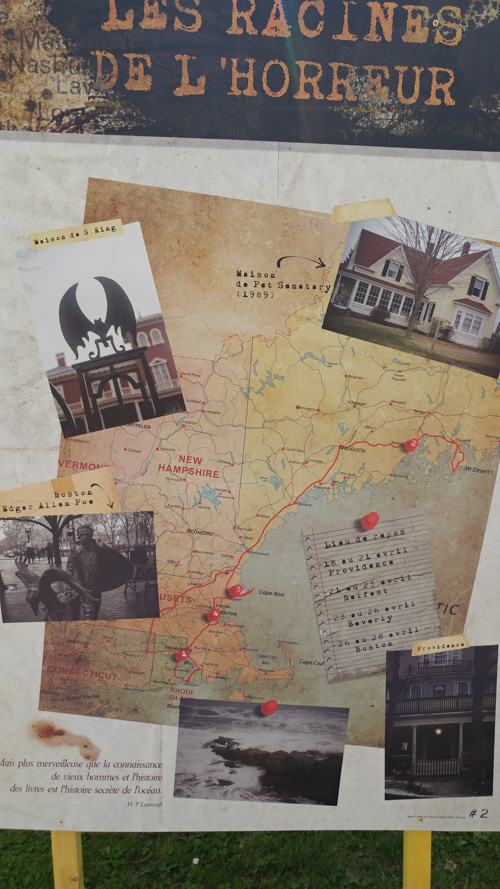
One of the posters describing the life and work of Lovecraft at the Les Imaginales literary festival
One of the highlights was the artwork of a very young artist, Laurent Gapaillard, whose work was featured at an exhibit at a nearby art gallery. The following image cannot even begin to do justice to the incredible detail and spectacular cosmicism of his work, dimly reminiscent of Gustave Doré or Piranesi but truly original and evocative:
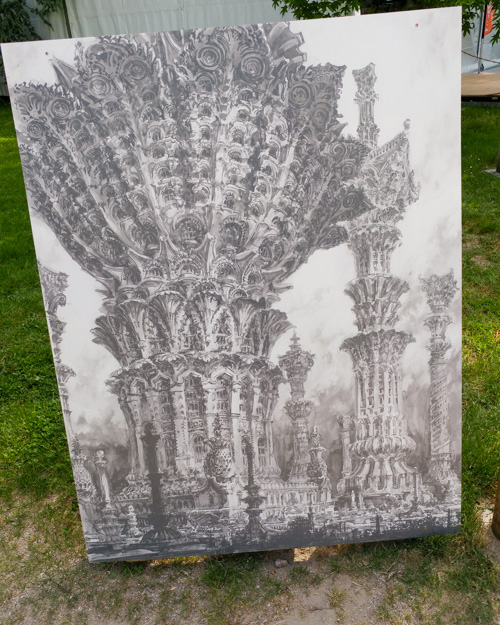
A work by Laurent Gapaillard “cannot even begin to do justice to the incredible detail and spectacular cosmicism of his work”
I was on one panel discussion on Lovecraft, and also gave a solo interview. In these proceedings I was aided by a superlatively skilled translator, Morgane Saysana, who did a phenomenal job in translating my often wordy responses into elegant and fluent French. She also assisted in some of my interviews, although several of these were conducted entirely in English. My publisher, Jerôme Vincent, was also present at a large booth featuring his new publications. And I spent much time with Christophe Thill and his wife, Barbara. Christophe was the supervisor of the French translation of my book, which required ten translators working for a year! I met some of these—including Thomas Bauduret and Annaïg Houesnard—at a dinner on Friday night in Épinal. (I will remind readers that I still have a spare copy of this two-volume French translation, which I am now prepared to let go for the bargain price of $40.)
We returned to Paris on Sunday evening. Monday (May 27) we expected to spend all day in the Louvre, but after standing in line for close to two hours we learned that the museum staff had gone on strike and that the museum would not be open at all that day! This was doubly unfortunate, since many other Paris museums (including the Rodin Museum) are closed on Mondays. We just headed out on a walking tour of the general area, taking in the Église de la Madeleine (a huge church that has the look of a Roman public building), the Place Vendôme, the Tuileries gardens, and so on.
That evening we met Gilles Menegaldo and Martine Chifflot. I had already met Gilles in Épinal, and was interviewed by him on Sunday for a documentary on Lovecraft that he is planning. Martine is also planning a documentary, and she interviewed me (and Gilles) at length before dinner. Martine is the author of Howard, Mon Amour, a delightful short play about Lovecraft and Sonia that she is turning into a film. She has also arranged to have the work translated, and I hope to find a suitable US publisher for it. Here is a picture of the three of us outside a charming used bookstore near our restaurant:
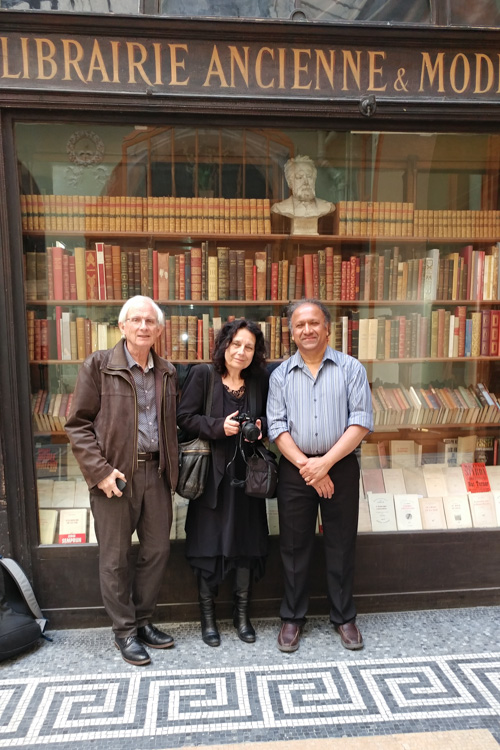
Gilles Menegaldo, Martine Chifflot, and S. T. Joshi in Paris, outside Librairie Ancienne et Moderne B. Faure, “a charming used bookstore near our hotel”
Overall, my trip to France was splendid, even if busy and exhausting. I felt, for the first time in my life, like a celebrity. My biography is apparently causing something of a sensation, as it has already been written up in several newspapers and magazines (it came out in March), and I am enormously grateful to Christophe Thill and his team of translators, not to mention Jerôme Vincent of ActuSF, for bringing it out in such an impressive and attractive edition. Let’s hope it helps to clear away many of the misconceptions about Lovecraft’s life and work that still seem prevalent in France and elsewhere!
On another note entirely:
I have now received copies of The H. P. Lovecraft Cat Book, the newest publication from Necronomicon Press. It is a splendid-looking item, and I will be happy to part with my spare copies for $15 each.
Now to plan for my big trip to Australia (June 19–July 8)!
May 15, 2019 — “Sunset” Is Performed
On Saturday, May 11, at the First Free Methodist Church in Seattle, my little composition for a cappella (unaccompanied) choir, “Sunset” (based on the Lovecraft poem), was performed. It was a creditable performance, and my webmaster, Greg Lowney, videotaped it. You can see it here: https://youtu.be/Hy8sLLmj9RA. You will see that our accompanist, Carol Buschmann, plays along with the choir on the piece, to help us out a little. And of course you can see me, with my balding pate, in the centre of the group.
We will of course repeat the performance at Edmonds United Methodist Church on Saturday, May 18.
The day after that, Mary and I will head to France, to participate in various events surrounding the publication of the French version of my biography, Je Suis Providence, by Éditions ActuSF. I was thrilled to receive two copies of this fine paperback edition; it is selling for a combined price of 55 euros. If anyone cares to have my spare set, I will gladly part with it for the bargain price of $50.
Most of my time in France will be spent at a large science fiction convention, Les Imaginales, in the town of Epinal, near the German border. I will participate in some panel discussions and also be interviewed by longtime Lovecraft scholar Gilles Menegaldo. But Mary and I hope to get some touristing done as well, taking in the Musée d’Orsay, the Louvre, and the Catacombs on our few days in Paris.
I have just received copies of my selection of Robert Aickman’s eighteen best tales as published by Centipede Press in the Library of Weird Fiction series. It is a beautiful-looking volume of some 685 pages, well worth securing for those who do not wish to wade through my massive (and expensive) two-volume edition of Aickman’s forty-eight weird tales, issued earlier by Centipede Press in the Masters of the Weird Tale series. This new volume(http://www.centipedepress.com/masters/aickmanlwf.html) is being offered for $45, so I will offer my three spare copies for $40.
I have also received a copy of an edition of William Hope Hodgson’s selected tales issued by the British Library, titled simply The Weird Tales of William Hope Hodgson, and edited by Xavier Aldana Reyes. I provided the electronic texts of the stories used in the volume. Here is the publisher’s website for the book: https://www.bl.uk/shop/the-weird-tales-of-william-hope-hodgson/p-3077.
Some time ago I received several copies of the Necronomicon Press publication of Lovecraft’s The Lurking Fear (https://necropress.com/h-p-lovecraft-clark-ashton-smith-robert-h-knox-the-lurking-fear/). This is a facsimile reprint of the serialisation of the story in Home Brew (January–April 1923). Such a reprint was among the first publications of Necronomicon Press, all the way back in 1977. This new reprint has been “modified” to the extent that the talented artist Robert H. Knox has enhanced the black-and-white illustrations of Clark Ashton Smith by the use of vivid colour. I have written a brief introduction to the book. The list price is $14.95, but I will be happy to let my spare copies go for $10 each.
Otherwise, things proceed here at their usual hectic pace. Hippocampus Press has been a bit slow in getting books out this year, but we hope to pick up the pace substantially in the coming months. Volumes of Lovecraft’s letters (to Donald Wandrei and Emil Petaja; to Wilfred B. Talman and Helen V. Sully); the Leah Bodine Drake omnibus; the Clark Ashton Smith bibliography and a volume of the letters of Smith and August Derleth; the three-volume edition of Arthur Machen’s collected fiction; and much else besides can be expected. There will also be a slim volume of stories by the late W. H. Pugmire, which I have entitled An Imp of Aether. I am already up to 280 published titles, and it is a frightening thought that I may actually hit 300 before the end of the year.
As for my own Sarnath Press, I continue to issue volumes of Mencken’s essays and journalism (thirteen have been published to date). In this venture I have been substantially assisted by several librarians at the Enoch Pratt Free Library in Baltimore, especially Vincent Fitzpatrick, the curator of the H. L. Mencken Collection. Another volume that I am contemplating, out of sheer egotism, is an omnibus of my interviews. I have given many, many interviews over the years, most of them via email in which I have typed out my responses in a Word file. So I have the texts of these interviews ready to hand. But I have a suspicion that I have ended up saying the same things over and over again, so the utility of such a volume is highly questionable.
The next issue of Dead Reckonings (#25) will include my review of James Machin’s Weird Fiction in Britain 1890–1939 and also an extensive interview of me by editor Alex Houstoun concerning my treatise 21st-Century Horror. I think the issue (theoretically dated Spring 2019) is already a bit late, so let’s hope it will appear soon. Spectral Realms #11 (Summer 2019) is nearly finished, as is the Lovecraft Annual for this year.
April 30, 2019 — A Visit to CAS Country
I was thrilled to spend some time in Auburn and Placerville, California, and look up some of the Clark Ashton Smith sites in the area. I had come down to participate in a showing of Darin Coelho Spring’s superlative documentary on Smith, in which I appear. This film was showed on Friday, April 26, at the Auburn State Theatre—but I had come on Wednesday, along with Derrick Hussey, and we were both put up in Darin’s spacious home.
On Thursday, we made an exhaustive tour of the CAS sites. This included his birthplace, which had been built by his father and where he lived for about the first seven years of his life. But, sadly, the house was recently vandalised, with many windows being shattered and even some parts of the interior being damaged. Nonetheless, I took a photo of it with my phone:

Clark Ashton Smith's birthplace in Auburn, California.
Next I was taken to the little schoolhouse (technically in the community of Long Valley) where Smith attended grammar school:

The schoolhouse where Clark Ashton Smith attended grammar school.
This school was built around 1890 and is now preserved by the Placer County Historical Society.
Smith only attended a single day of high school, so he was largely self-taught. He apparently spent a great deal of time at the Auburn Public Library, one of the many libraries built by funds provided by Andrew Carnegie. The building still stands, although it is not used as a library anymore:
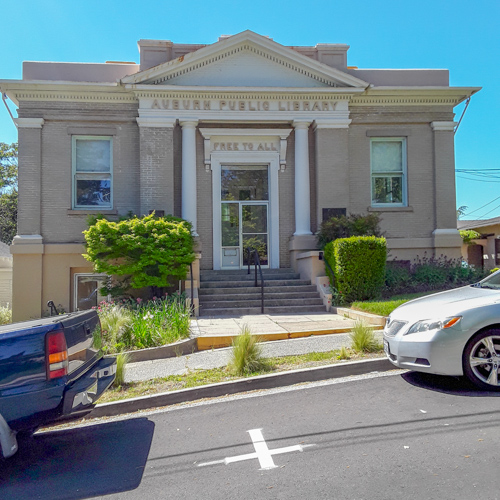
The former Auburn Public Library where Clark Ashton Smith educated himself.
Auburn itself is now coming to recognise Smith as a notable resident. There is a street where such celebrities (most of them being either sheriffs or outlaws!) are now heralded with star-shaped emblems on the sidewalk, and Smith now has one:
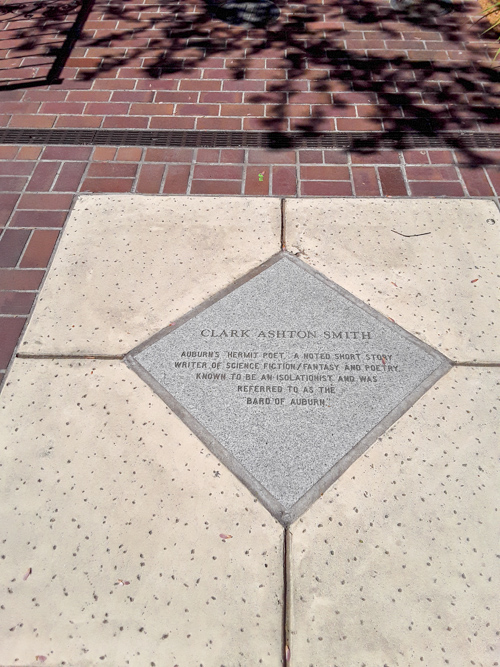
The sidewalk plaque commemorating Clark Ashton Smith.
The emblem curiously states that Smith was an “isolationist” (i.e., a recluse). A more distinguished plaque appears on the current Auburn Public Library:
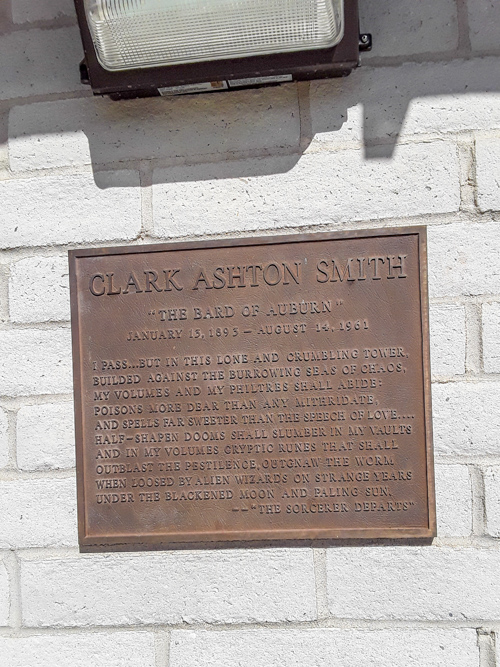
The plaque commemorating Clark Ashton Smith at the Auburn Public Library.
But the most touching memorial to CAS appears in Centennial Park, where a boulder rests above CAS’s ashes and a plaque has been placed in front of it:
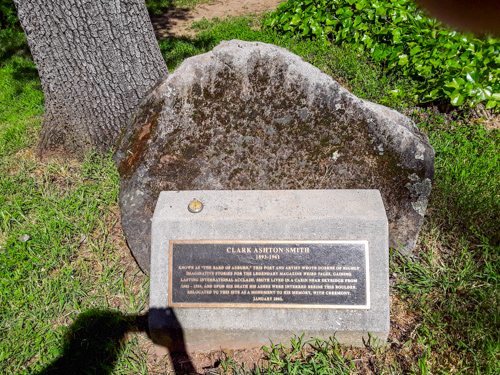
The plaque commemorating Clark Ashton Smith and the stone where his ashes were buried.
All in all, it was a wonderful visit—made more interesting by lively discussions with other such notables as Ashley Dioses, K. A. Opperman, Scott Connors, Ron Hilger, Charles Schneider, and others. And, of course, Darin and his family were models of hospitality and consideration.
The documentary was fairly well attended and very well received, and a few of us who appear in it (including Cody Goodfellow and the artist known as Skinner) conducted a Q&A session afterwards. Skinner presented me with a delightful pop-up book featuring Lovecraftian entities! Just the thing to inculcate your infant into the world of Lovecraftian terror. This is called The Necronomicon Pop Up Book (https://www.necronomiconpopup.com/), and it is well worth getting.
On to other matters …
Necronomicon Press is officially taking advance orders for my H. P. Lovecraft Cat Book, which comes to 156 pages and features tales, poems, essays, and extracts from letters where HPL discusses his favourite species (https://necropress.com/the-h-p-lovecraft-cat-book/). I’m pleased to noe that it will appear in both a limited hardcover edition as well as a trade paperback edition. The best features, of course, are the wondrous and exquisite illustrations by Jason C. Eckhardt, who (along with HPL and myself) is also a devotee of felines.
For those of you in Rhode Island, the Hearthside House Museum in Lincoln is planning a “Meet H. P. Lovecraft” session on May 5 (https://www.hearthsidehouse.org/lovecraft). Lincoln is the site of Quinsnicket Park, where Lovecraft was fond of venturing for relaxation and to absorb the natural beauty of the region. His early poem “Quinsnicket Park” (1913) attempts to capture his fondnes for the area. Don’t miss this event if you are within striking distance of it!
In terms of my own work, I have issued an anthology of writings on atheism and freethought, Advocating Atheism, through my Sarnath Press imprint. This book consists of the 38 items I included in the “Classic Reprints” section of the American Rationalist during my editorship (2011–17). Among the notable writers are Thomas Henry Huxley, Ambrose Bierce, H. L. Mencken, Bertrand Russell, and Thomas Paine.
I now see that The PS Book of Fantastic Fictioneers is finally close to publication by PS Publishing in the UK (https://www.pspublishing.co.uk/the-ps-book-of-fantastic-fictioneers-hardcover-edited-by-pete-von-sholly-4806-p.asp). This immense two-volume compilation presents a series of essays on notable authors of weird and speculative fiction (including several filmmakers and contributors to other media), all lavishly illustrated with interesting documents and other items. I contributed four or five essays. This project has long been in the works, and I am gratified to see it finally appear.
A final reminder that the memorial for Wilum Pugmire will be on May 4 at the Wedgwood Community Church (8201 30th Avenue NE) here in Seattle. It should be a fine event. A week later, my choir will give the first of two performances of its spring concert, including the world premiere of my own little composition, “Sunset” (based on the poem by Lovecraft): http://www.nwchorale.org/. Here’s hoping you can attend either this concert or the one on the 18th.
The day after the second concert…I head to France! More on that later.
April 6, 2019 — More on Wilum, and Other Matters
The outpouring of grief spurred by Wilum’s passing seems unabated. I myself have received many messages of condolences from people both known and unknown to me, and I am grateful for them all; I apologise if I have not made individual replies to some of these messages. Meanwhile, I can report a number of developments designed to keep Wilum’s memory alive.
We are planning a memorial event (we will not call it a service) on Saturday, May 4. That may seem a long time after his passing, but we hope to commemorate his life rather than his death; and as his birthday was May 3, this date seems appropriate. We are contemplating renting a public space for the event, depending on how many people wish to attend. So I would be grateful if interested persons could contact me, Mary, or Greg Lowney, so that we can gauge how big a space we may need.
Brian Keene recently posted a podcast full of tributes to Wilum. I was happy to allow Brian to read my last blog on the podcast (http://thehorrorshowbk.projectentertainment.libsynpro.com/w-h-pugmire-remembrance-the-horror-show-with-brian-keene-ep-214). No one needs to be reminded that Brian and I have not exactly gotten along lately, but an event like Wilum’s passing sometimes brings people together, and I responded eagerly to Brian’s cordial invitation to participate in the podcast.
Many people who know Wilum only through his weird fiction are unaware that he was prominent, even if only locally, in several other realms. In particular, his role as a devotee and promoter of punk rock in the 1980s has been widely recognised. His fanzine, Punk Lust, was highly influential in promoting his favoured musicians and in eliciting discussion of the punk rock movement; in those pre-Internet (and pre-computer) days, I recall him telling me how he diligently assembled each issue in a manner not at all dissimilar to fanzine editors dating back to the 1930s. I also recall seeing an extensive article on Wilum in the Seattle Post-Intelligencer in 1988, and Leigh Blackmore has recently posted this piece (“GHOST WRITERS: Seattle’s horror-fiction authors find our region’s gloomy days nourish their creative spirits”, Seattle Post-Intelligencer, October 30, 1988, page K 1).
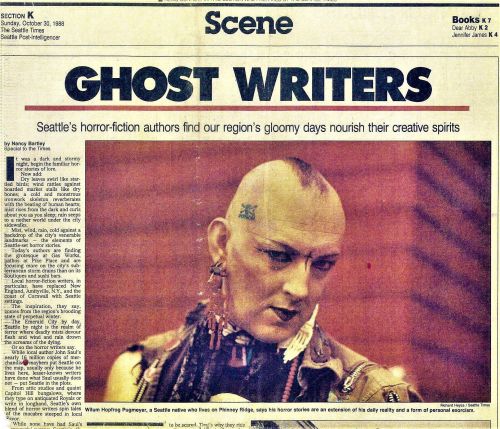
“Ghost Writers” in the Seattle Post-Intelligencer of October 30, 1988.
More recently, an article in the Seattle Review of Books mentions Wilum frequently in his role as a punk rock advocate: https://www.seattlereviewofbooks.com/reviews/punk-snot-dead/.
I am doing my humble part in the perpetuation of Wilum’s work. It appears that I will be named his literary executor, in accordance with his wishes. Already I have received inquiries from a publisher in Spain interested in issuing one or more volumes of Wilum’s tales; as soon as my executorship is legally established, I will sign agreements with this publisher and any others who are interested. I will not accept any pay for this work, instead forwarding all revenues to Wilum’s surviving sister, Holly White.
Wilum wished me to take possession of his personal library. I am in the process of doing so, but I do not wish to profit from this material. Instead, working with Holly and Greg Lowney, I will at some point arrange a sale of the books in his library, with all the proceeds going to the John Hay Library of Brown University so that it may purchase Lovecraft manuscripts and letters. I believe Wilum would be pleased by this. Wilum had an impressive collection of Arkham House books along with books on many other subjects (notably Shakespeare, Henry James, and Oscar Wilde). It may take us some months to catalogue all these books and prepare a list for sale, but we will keep you posted on developments.
I managed to complete the choral setting of Lovecraft’s “Continuity” that I had begun working on some time ago. It is quite a bit longer than my setting of Lovecraft’s “Sunset” (which my choir is rehearsing for our upcoming performances on May 11 and 18), and I think it came out well. It is dedicated to Wilum. Here is the first page of the score:
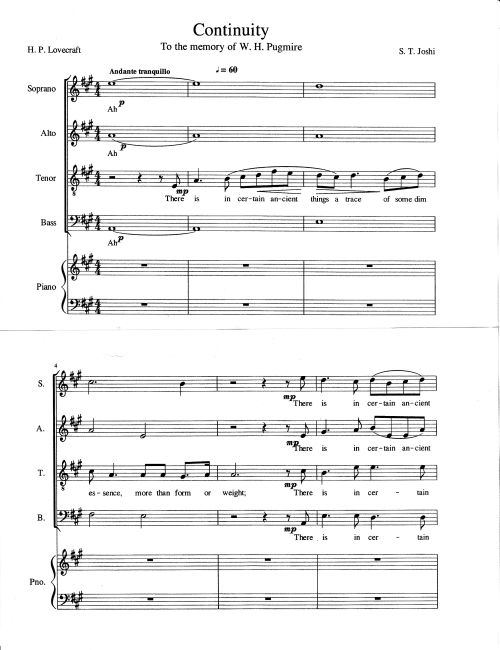
The first page of S. T. Joshi’s “Continuity”.
I still need to refine it considerably with various articulations, and I am hoping my choir might perform it for its Christmas concert in December.
Meanwhile, I am attempting to carry on with my own work as best I can. I surprised myself by completing a short detective novel, Honeymoon in Jail, featuring Lovecraft and Sonia as the detectives. I had begun this work four years ago (my computer file reports that the file was created in March 2015), but I had put it aside after writing about 15,000 words, thinking that it was not going well. Recently I re-read this portion and found that it seemed to have some promise, so I managed to finish the work. It is quite a short novel (just over 50,000 words). Mary and Jonathan Thomas (perhaps not entirely impartial judges) both seem to like it, and I offered it to Sam Gafford’s Ulthar Press, and he promises to get it out sometime next year.
PS Publishing finally seems to be moving on some of my long-delayed projects there, including my anthology Apostles of the Weird and my novella Something from Below. The latter will be illustrated by John Coulthart, the immensely talented artist whose work I have been admiring since I first saw it in the 1980s. PS is also sitting on other books (The Best of Black Wings, His Own Most Fantastic Creation [the anthology of stories using Lovecraft as a character], and my revised study of Ramsey Campbell). These books will, I trust, appear in due course of time.
I now have two copies of my 80 Years of Arkham House to sell, and I am happy to offer them for $15 each.
Scott Bradfield continues to do his part in promoting authors of interest to us. A recent piece in the Los Angeles Times on literary landmarks around Big Sur in central California makes numerous references to Clark Ashton Smith and George Sterling: https://www.latimes.com/books/la-ca-jc-big-sur-literary-destinations-20190329-story.html. Scott also plans to promote my forthcoming edition of Arthur Machen’s collected fiction in some appropriate venue, perhaps in the UK.
March 31, 2019 — My Friend, Wilum Pugmire
The winter of 2018–19 was unusually severe here in Seattle. In particular, in early February we suffered an unprecedented series of heavy snowstorms that paralysed the city. We rarely get snow, and the city is ill equipped to deal with it. Most of us were merely inconvenienced or housebound, but Wilum’s fate proved to be more severe.
He went into the emergency room in mid-February, complaining of chest pains and difficulty breathing. He was diagnosed with pneumonia. That didn’t sound too bad, but we were concerned—and frustrated—that he didn’t seem to be improving as quickly as he should have been. My wife, Mary, and I visited him several times and were alarmed to see him gasping and unable to sit up for any length of time. And yet, he nonetheless did seem to get better, and we learned that the pneumonia had finally left him. But he continued to linger in the hospital—for weeks, then for more than a month. It appeared that the pneumonia had exacerbated the heart condition he had been suffering from for years (and for which, I’m sorry to report, he didn’t take his medications quite as diligently as he should have).
At some point during that dreary month at Harborview Medical Center, he came to understand that the end had come upon him. He faced this realisation with what I thought was incredible grace and quiet resolve. He said that, a few weeks short of his 68th birthday, he had lived a full, rich life and had accomplished many of the literary goals he had set out for himself. And who can deny that?
By late March he decided that he would prefer to spend his last days at home, surrounded by his family, friends, and especially his beloved pets (which numbered six cats and two dogs). I spent much of the afternoon of Monday, March 25, with him, and he was indeed surrounded by some of the people (and there are many) who meant so much to him. I was present when, in accordance with his own wishes, his sister Holly turned off the heart pump that was largely keeping him alive. We had been told that this act might result in his death within minutes; but in fact he lingered for about ten hours, passing away in the wee hours of the morning of March 26.
And yet, I do not wish to speak of his death but of his life. I am no doubt one of many who regard him as one of the kindest, gentlest, most tolerant and generous human beings to have ever walked the earth. I know that the feuding that is so seemingly endemic to our social media culture saddened and dismayed him, and I take responsibility for contributing more than my share of abuse, insult, and billingsgate.
Many individuals knew him far longer than I did, but I like to believe we gained a special rapport because of our mutual devotion to H. P. Lovecraft. Wilum was reluctant to speak of himself, but he often regaled us with how he discovered the dreamer from Providence while conducting missionary work for the Mormon church, to which he remained devoted (in spite of the church’s own cruel prejudice—now only slightly moderated—against gays and other groups). While dodging bullets and bombs in Northern Ireland in the early 1970s, he stumbled upon a paperback of Lovecraft’s tales and was immediately captivated.
He wrote for years, even decades, in obscurity—but his creative work was an act of love, not commerce, just as it had been for Lovecraft. He was as surprised as any when, after so many years, he gained a following and saw his work published far and wide. He was tickled when, only a few months ago, a German edition of his tales appeared.
He and I became close when I moved to Seattle from the East Coast in the fall of 2001. He would often stop by at my house in the university district, on his way to or from the Mormon temple nearby. Later, Mary and I would often have him over for dinner, and we were pleased at how much relish he took in the dishes she offered (and why not?—she is an excellent cook). In particular, we enjoyed sharing with him the large Virginia ham that Derrick Hussey would habitually send to me as a Christmas present.
He was also a central figure in our local “gang” of Lovecraftians. Although his native shyness made him a largely silent participant in our gatherings, he would occasionally add a charming anecdote or make some other remark that displayed both his shrewdness and his humanity.
One of the greatest thrills of his life was visiting Providence in 2007, where he could at last walk in the footsteps of his literary master. That trip inspired dozens of tales, including some of his best. He attended the H. P. Lovecraft Festival in Portland as often as his health would allow, although later admitting that such trips (including one that he took just last year) overtaxed him and probably worsened his heart condition. But at least some of his many friends and devotees had a chance to meet him in person as he sat placidly on a bench outside the Hollywood Theatre and spoke a kind word to all and sundry.
We disagreed on several subjects, but that did not lessen our bond. As an atheist I was bemused by his Mormon faith; and part of the tranquillity he exhibited at the end was inspired by his firm belief that, after his transition out of this life, he would meet all the people who had meant so much to him—not just friends and family members but the great literary figures (Shakespeare, Henry James, Edgar Allan Poe, Oscar Wilde, and Lovecraft himself) whom he idolised. If that belief gave him comfort in his final hours, who has the right to deny it to him?
This is not the place for an evaluation of Wilum’s literary work. Impressive as that work is, it is the human being I care to remember. When Lovecraft himself died, tragically early, there was an outpouring of grief just as there has now been for Wilum; and a longtime friend, Charles W. Smith, summed up his sense of closeness to Lovecraft by the simple words, “He was my friend.” I am one of many who can consider themselves lucky to have been Wilum’s friend. The world is a little poorer without him.
March 24, 2019 — Books and Recordings
I have not felt much inclined to write a blog lately, chiefly because of the grave illness of my friend Wilum H. Pugmire. Mary and I visited him in the hospital several times (he was there for more than a month), and also paid him a visit a few days ago, when he chose to come home. Otherwise, I am trying to carry on as best I can, and I feel that Wilum himself would wish me to do so.
The latest Sarnath Press title is a thorough revision of Sixty Years of Arkham House (1999), now titled Eighty Years of Arkham House. This version brings the book up to date by including all publications by Arkham House (and its subsidiary imprints) down to 2012 (no book has appeared since that date). Since it seems unlikely that Arkham House will ever issue another book again, I trust this edition may be regarded as a reasonably definitive bibliography (and index) of the publications of this legendary small press. I will have a few copies of this book to sell for $15.
Another project that has inspired me of late is a push to issue the bibliography of George Sterling that Alan Gullette and I (with substantial assistance from David E. Schultz, although he is not listed as a co-author) assembled some years ago. It proved unfeasible to issue the compilation in conjunction with my edition of Sterling’s Complete Poetry (2013), and so I thought I would simply get it out from Sarnath Press. But Derrick Hussey has offered to issue it this summer or fall from Hippocampus, and I have readily assented. (I trust Alan will also be in agreement, although as of this writing I have not heard from him on the matter.) I do hope the bibliography leads to further work on Sterling, even though there seems to have been little criticism of him in the past decade or so. Indeed, I myself am now slowly wrapping my mind around the prospect of writing a detailed biography of Sterling, perhaps as the chief figure of the bohemian circle he gathered around himself (and which included such figures as Jack London, Mary Austin, Upton Sinclair, and many other luminaries—all apart from Sterling’s association with Ambrose Bierce).
I am in receipt of several LPs from Cadabra Records that feature liner notes that I have written. These are: Robert W. Chambers’s The Yellow Sign (read by Anthony D. P. Mann); Lovecraft’s Dagon, The Cats of Ulthar, and The Music of Erich Zann; and Lovecraft’s The Call of Cthulhu (both of these read by Andrew Leman). See Cadabra’s website (http://www.cadabrarecords.com/) for these and other interesting items.
Some very tempting items from Hippocampus Press are forthcoming. Two projects that have been in the works for many years now seem on the verge of publication: T. E. D. Klein’s Providence After Dark (a massive collection of his essays and reviews), and Matt Cardin’s To Rouse Leviathan (a volume of his collected fiction). I initially assisted Ted Klein in assembling his nonfiction some years ago, but lately he has taken the project in hand and added a number of pieces of which I was unaware. I will not be listed as editor of the book, but I may add a brief introduction providing an overview of the contents. Cardin’s volume is a rich storehouse of short stories and novellas inspired by Lovecraft, Ligotti, and other writers, but infused with Cardin’s own distinctive vision.
I am working hard on editing Ambrose Bierce’s letters, a project that will extend to three volumes, and which the luckless Derrick Hussey will probably be obliged to publish under the Hippocampus Press imprint—although that may not happen until 2020 or even 2021. There are a number of tough issues that I may not be able to resolve without a trip to various archives in California, and I’m not sure when I will be able to schedule such a trip. But I am committed to this project, on which I have been working off and on (mostly off) for more than two decades.
A trip to California is indeed in the offing, but for the purpose of attending a showing of the Clark Ashton Smith documentary in Auburn on April 26. Derrick Hussey will come in from New York, and other luminaries—including, of course, the filmmaker himself, Darin Coelho Spring—should be in attendance. It is good to see Smith’s hometown finally acknowledging his importance. I hope to see whatever Smith-related sites there may be in Auburn.
A colleague has notified me of a notable indication of Lovecraft’s ascending fame: an adaptation of The Case of Charles Dexter Ward on BBC radio (https://www.bbc.co.uk/programmes/p06w5zwg). I have not listened to any episodes of this item, but I am confident it is well done.
I have managed to write a few more “grammar points,” including my two chief bugbears (the misuse of “like” for “as” or “as if”; and the erroneous “of” after “all”), so please consult that page for the new entries.
March 7, 2019 — A Surfeit of Books and Magazines
It is with some trepidation that I announce the appearance of yet another sheaf of books and magazines that I have written or edited. I pity the pocketbooks of my devoted readers! Some of these items have been out for some time, but I have only now received copies.
First up are two magazines from Hippocampus Press, Dead Reckonings #24 (dated Fall 2018) and Spectral Realms #10 (Winter 2019). The former contains my joint review of two of Ramsey Campbell’s recent books, By the Light of My Skull (a story collection) and The Way of the Worm (the final instalment of his spectacular Daoloth trilogy), as well as an essay on Adam Nevill (a somewhat condensed version of the chapter on him from 21st-Century Horror). The issue of Spectral Realms contains, in addition to the usual array of splendid poetry, a complete index to all ten issues. I am happy to offer these items for $5 (Dead Reckonings) and $10 (Spectral Realms), respectively.
In addition, my long-awaited edition of Théophile Gautier’s The Mummy’s Foot and Other Fantastic Tales is out from Hippocampus. The book is dated 2018 but, I believe, only appeared last month. It is a whopping 418 pages and contains, in addition to the complete contents of One of Cleopatra’s Nights and Other Fantastic Romances (as translated by Lafcadio Hearn), three substantial novellas—Avatar (translated by Edgar Saltus), Jettatura, and Spirite (the latter two translated by F. C. de Sumichrast, who translated the totality of Gautier’s fiction in a multi-volume edition in 1900–03). I have numerous copies of this book and can offer them at $15 each.
Last (and probably least), I have issued through Sarnath Press my own collected mystery and horror fiction under the title The Recurring Doom: Tales of Mystery and Horror. This fat (432 pp.) book contains my two short detective novels, The Removal Company and Conspiracy of Silence (featuring my hard-boiled detective from the 1930s, Joe Scintilla), a detective novella, “Tragedy at Sarsfield Manor” (whose initial draft was written while I was at Brown, in 1979), along with six short stories. This is, of course, not the entirety of my fiction writing: it does not include my novel The Assaults of Chaos (2013) nor my forthcoming novella Something from Below (due out soon, I trust, from PS Publishing). In addition, it does not include another work I have recently written, but which I will not discuss at this time.
I have exactly two copies of The Recurring Doom to sell, and am prepared to let them go for $20 each. To sweeten the deal, I will throw in the new Dead Reckonings at no charge and also offer the new Spectral Realms for an additional $5. Indeed, I will make this offer apply to purchasers of the Gautier book book as well (but please be aware that I have only four copies of Dead Reckonings available).
And I am now able to make another momentous announcement: I have spent the last several months preparing a complete edition of the fiction of Arthur Machen. This will appear in a three-volume trade paperback edition from Hippocampus Press very shortly, perhaps within two or three months. I have just received a set of advance review copies of this set. This edition contains all four of Machen’s novels (The Chronicle of Clemendy, The Hill of Dreams, The Secret Glory [with the inclusion of the final two chapters, which had been excised when the novel was first published in 1922], and The Green Round), along with all his great weird short fiction (“The Great God Pan,” “The White People,” etc., etc.) all the way down to his last published story, “Ritual” (1937). I have been very scrupulous in the prepration of the text, as I have attempted to ascertain Machen’s preferences in spelling, punctuation, etc. (largely based on the manuscript of those two final chapters of The Secret Glory, which I obtained from Yale University’s Beinecke Rare Book and Manuscript Library decades ago). And I have actually found one (very short) story that has never been reprinted since its original appearance!
The edition will appear in conjunction with a fine anthology of Machen criticism edited by Mark Valentine and Timothy J. Jarvis. It will be another stellar addition to Hippocampus’s line of weird fiction criticism, to join the volumes devoted to M. R. James, J. Sheridan Le Fanu, and others.
With this Machen edition, I have now edited the complete fiction of Lovecraft, Ambrose Bierce, M. R. James, Arthur Machen, and a host of lesser writers. (It is impracticable to prepare a complete edition of Lovecraft’s two other “modern masters,” Algernon Blackwood and Lord Dunsany, given their enormous output; but I hope to get out more editions of their work in due course of time.)
Another book that will appear soon from Hippocampus is Leah Bodine Drake’s The Song of the Sun—essentially, her collected poetry, fiction, essays, and even a selection of letters (to August Derleth, Anthony Boucher, and others). This enormous volume, extending to about 600 pages, was largely edited by David E. Schultz, and I have been something of a freeloader on the book, to the point where I wonder whether my name should even be listed as co-editor. In any case, it will be a beautiful hardcover book—although it will probably not be available until the summer. But advance review copies are now going out.
Another book that should appear soon is Eccentric, Impractical Devils—the whimsical title we have affixed to the collected letters of Clark Ashton Smith and August Derleth. Recently a previously unknown batch of Derleth’s letters to Smith came to light, causing us to refashion the book almost in its totality—and forcing me to re-index nearly the whole of the book. Gawd, what a nightmarish task! But the job is done at last, and I hope the book will emerge soon—along with the huge Clark Ashton Smith bibliography that Scott Connors, David E. Schultz, and I have edited.
I am happy to announce a new page of this website—devoted to “Grammar Points.” As readers of my recent articles and reviews have observed, points of grammar, style, and punctuation have increasingly come to dominate my interest, and I find a dismaying inattention to such matters in contemporary writing. I am aware that almost anything goes in today’s lax climate; and, as a literary critic, I am also aware that writers are allowed the liberty of bending of breaking the formal rules of grammar for specific purposes. But it strikes me that many of today’s violations of standard grammar are due to sheer ignorance and therefore can only be deprecated. My initial grammar points are somewhat minor and random, as I do not yet have the time to devote to more complex issues (in particular, my two chief bêtes noires—the misuse of “like” for “as” or “as if” and the erroneous insertion of “of” after “all”); but I will get to these and other points in due time, so please continue checking this page for updates!
February 13, 2019 — Weird Fiction Review Out at Last
This blog will be rather short, for a variety of reasons—not the least of which is that here in Seattle we are dealing with an unprecedented succession of snowstorms that have paralysed the city. I myself have had to shovel snow on several consecutive days—and I doubt that I have shoveled more than four times total in all the years I have lived in this otherwise temperate city. Driving is incredibly treacherous, especially for those of us who live on side streets that have no hope of getting ploughed by the meagre resources this city has for such a purpose.
But I am happy to announce that the much-delayed issue of Weird Fiction Review (the ninth annual issue) is now out from Centipede Press (http://www.centipedepress.com/anthologies/wfreview9.html). I see that the publisher is currently offering the issue for a bargain price of $22, so I will undercut him by offering my four spare copies for $20 on the usual terms. It is a splendid issue, with all manner of stories, articles, and artwork, and featuring the usual splendid Centipede Press design. This will be the last issue I edit, as the publisher will now enlist a rotating series of guest editors for each successive issue.
Dark Regions Press informs me that the ebook version of my anthology A Mountain Walked is being promoted on a special sale by BookBub, with a substantial reduction in price for both the US ($1.99) and UK (£1.99) editions. Here is the link to the US edition: https://www.amazon.com/Mountain-Walked-Neil-Gaiman-ebook/dp/B018829F8E; and the UK edition: https://www.amazon.co.uk/Mountain-Walked-Neil-Gaiman-ebook/dp/B018829F8E.
A welcome book that has come in recently is Frank Coffman’s outstanding poetry volume The Coven’s Hornbook and Other Poems (Bold Venture Press, 2019). Here is the publisher’s web page for the book: https://boldventurepress.com/the-covens-hornbook-other-poems/. This substantial collection (254 pp.) is well worth obtaining by any devotee of weird poetry. A number of the poems in it have appeared in Spectral Realms.
Another book that has made its way here is The Best of the Scream Factory (Cemetery Dance, 2018: https://www.cemeterydance.com/the-scream-factory.html). This weighty hardcover volume contains my article “How Bad Are Lovecraft’s Revisions?” (from the Autumn 1992 issue). Needless to say, it has many other items of interest.
More later, when the snow melts away!
January 23, 2019 — Ave Atque Vale and Others
I am happy to announce receipt (at last) of copies of Ave atque Vale: Reminiscences of H. P. Lovecraft, an immense (502 pp.) compilation of Lovecraft memoirs assembled by David E. Schultz and myself and published by the revived Necronomicon Press (https://necropress.com/ave-atque-vale-reminiscences-of-h-p-lovecraft/). Comparisons will inevitably be made with Peter Cannon’s outstanding volume, Lovecraft Remembered (Arkham House, 1998); we have included most of the material in that volume (some items were omitted for copyright issues; others for editorial reasons) and included several newly discovered memoirs not included in Peter’s volume. The new book is issued in both a limited hardcover and a trade paperback edition, the latter costing $29.95. I have several copies of the paperback and will be happy to let them to go interested customers for $25.00.
For those who are curious as to the meaning and pronunciation of the book’s title, I can state that the phrase is Latin for “hail and farewell” (atque is somewhat more emphatic than et, although both mean “and”). As for pronunciation—well, this varies depending on whether the phrase is used in prose or in poetry. In prose, it would be rendered something like: “AH-veh [not -vay] aht-queh VAH-leh.” But in poetry, the second syllable of the first word is elided, because it is followed by a word beginning with a vowel. Hence it would be rendered as “AHV’ aht-queh VAH-leh.” Its most famous usage occurs in one of the most poignant lines in the entire range of Latin poetry—Catullus’ poem 101, an elegy on his dead brother: “atque in perpetuum, frater, ave atque vale” (and for all eternity, my brother, hail and farewell). (Note here that the second syllable of the first “atque” is also elided—i.e., “atqu’in”). I can never read that line without choking up—just as I can’t read the final line of Clark Ashton Smith’s elegy on Lovecraft (“And from the spirit’s page thy runes can never pass”) without choking up.
Another book that has emerged is my Development of the Weird Tale, another publication from Sarnath Press. (See the Sarnath Press page for a link to the Amazon entry.) The table of contents of this collection of my miscellaneous essays on weird fiction—ranging from the work of Mary Shelley to the films of Guillermo del Toro—can be found in my blog of September 10, 2018. I will be ordering no books to sell to customers, so people will have to purchase directly from Amazon.
I am in receipt of a new book (although it appears to have emerged in late 2018), Edgar Allan Poe’s The Masque of the Red Death and Others, illustrated by Jason Eckhardt and published by Sam Gafford’s Ulthar Press, 2018 (https://ultharpress.com/). I wrote the introduction to the book. Of course, the book is noteworthy because of Eckhardt’s spectacular illustrations, which evoke all the terror and weirdness of Poe’s text. The list price of the book is $11.95. I have exactly one spare copy that I will be happy to let go for $10.
I was much engaged by two recent podcasts by noted writer and critic Scott Bradfield, available on YouTube. The first (https://www.youtube.com/watch?v=thzC1LDdPw4) discusses a number of my Penguin editions—M. R. James, Blackwood, and others. The other (https://www.youtube.com/watch?v=hPhB5k6Cs8w) is interesting in presenting the impressions of a reader relatively unfamiliar with Lovecraft—and of one who has now reassessed his opinions of the Providence writer and found him much more worthy of consideration than before. The amusing thing is that in these videos Bradfield actually pronounces my last name correctly, but (as so many others have done) flubs on the proper pronunciation of “Cthulhu” (also of “Dunsany”). I have, in my smart-aleck way, pointed out these errors, and Scott promises to correct them in a future podcast.
Another item that has drifted over here, this time from across the Atlantic, is The Green Book, an exceptionally well-produced periodical devoted to “Writings on Irish Gothic, Supernatural and Fantastic Literature,” edited by Brian J. Showers. Issue 11 (Bealtaine 2018) has numerous contributions about Lord Dunsany, including Darrell Schweitzer’s “How Much of Dunsany Is Worth Reading?” (first published in Studies in Weird Fiction, Fall 1991), Martin Andersson’s “Lord Dunsany and the Nobel Prize,” and Mike Carey’s “Appreciating Fifty-One Tales.” The issue has other pieces by Richard Dalby, Reggie Oliver, David Longhorn, and several others. For ordering information, see the publisher’s website: http://swanriverpress.ie/greenbook.html.
I have been informed by Jerad Walters of Centipede Press that Weird Fiction Review #9 is at the printer, hence I imagine it will be ready soon. The issue is of course quite late, as it should have come out in the fall of 2018. But it will be well worth waiting for! This will be the last issue under my editorship, as the publisher now wishes to have rotating guest editors for each subsequent issue.
Otherwise, work continues here at its usual hectic pace. I am working on all manner of projects … Lovecraft’s Letters to Wilfred B. Talman and Helen V. Sully … a new edition of Samuel Loveman’s Out of the Immortal Night (2004), with considerable new matter … the complete fiction of M. R. James … the Ambrose Bierce letters … and, of course, my ongoing series of Mencken’s essays and journalism. Never a dull moment around here!
January 3, 2019 — Some of the Presidents’ Men
Mary and I had a most enjoyable holiday season, highlighted by a trip to Carmel Valley, Calif., to see my two sisters (Ragini and Nalini) and some members of their families. There was quite a haul in terms of presents, including some new slippers as well as sundry chocolates. But the choicest item was nothing less than some of the figurines of the U.S. Presidents that I had so fondly played with as a boy! Ragini found nine of these gents on eBay; I shall now have to find the rest.
Those who have read my memoirs will recall the passage in which I discuss this matter:
One very curious type of solitary play I devised for myself involved a set of tiny (about 2 inches high) porcelain figures of all the American presidents from Washington up to Lyndon Johnson. I have no idea how my mother obtained these objects, but they fascinated me from the start. The pedestals gave the dates of each president’s term in office, so that to this day I know the entire sequence of all the presidents and the years in which most of them served.
But I went beyond merely absorbing dry information about these august figures. I began concocting games in which the presidents figured as players—notably what I called “Presidents’ Baseball” and “Presidents’ Football.” For the former, I used a marble (I played with marbles quite a bit) as a (rather large, proportionately speaking) ball and used the pedestals to propel the ball crazily all across my room. (This was, I suppose, closer to kickball than baseball—but I didn’t care about such a trivial detail.) I am astounded that I didn’t break mirrors and other delicate objects in my room, but somehow I didn’t.
I have subsequently learned that these presidents were given out by the local grocery store (I believe it was the IGA) in Urbana, Illinois. I now own nine of them:
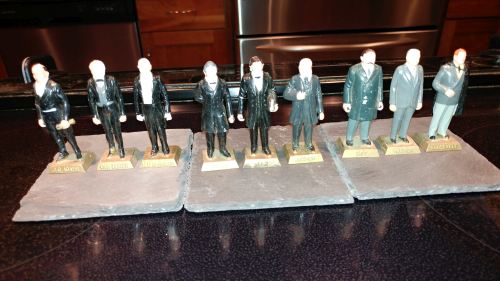
Nine U. S. Presidents
For those who are having a hard time making out the figures, they are (from left to right): John Quincy Adams, Martin Van Buren, William Henry Harrison, John Tyler, James Knox Polk, Chester Alan Arthur, William Howard Taft, Herbert Hoover, and Franklin D. Roosevelt.
In terms of work, I have now nearly finished my compilation of the weird tales of May Sinclair. I am currently reading some biographical and critical material on her for my introduction.
I am happy to announce the completion of His Own Most Fantastic Creation, an original anthology of stories using Lovecraft (or a Lovecraft-like figure) as a fictional character. Here is the list of stories:
| Death in All Its Ripeness | Mark Samuels |
| Worlds Apart | Donald R. Burleson |
| Witch’s Ladder | Donald Tyson |
| How Could It Be Elsewise? | Richard Gavin |
| A Gentleman of Darkness | W. H. Pugmire |
| The Feverish Stars | John Shirley |
| The Basilisk | David Hambling |
| Captured in Oils | Simon Strantzas |
| I Left My Soul at Murder Castle | Kirk Sigurdson |
| Dreams Are Forever | Scott Wiley |
| A Meeting Beneath the Moon | Mark Howard Jones |
| The Return of the Night-Gaunts | Darrell Schweitzer |
| The Gilman Woman | Stephen Woodworth |
| In His Own Handwriting | S. T. Joshi |
| Avenging Angela | Jonathan Thomas |
I hope PS Publishing can get this book out late this year. My own story was scheduled to appear in my fiction omnibus, The Recurring Doom (due out later this year from Sarnath Press), but it fortuitously fit the theme of the anthology so well that I have placed it there.
I expect 2019 to be a productive year from me, if for no other reason than that I expect to self-publish as many as 12 books of H. L. Mencken’s essays and journalism (2 per month). If you look at the Sarnath Press page, you will see that six of these volumes are already out, and I intend to get two more out this month. This will complete the eight volumes of his writings in the Smart Set, which will then be followed by miscellaneous magazine articles, prefaces and introductions to various books by others, and then the first of many volumes of his newspaper journalism. I don’t imagine these books are exactly flying off the shelves, but I will take personal satisfaction in their appearance.
With the advent of the new year I expect Hippocampus Press to issue several books that have been slightly postponed: the Clark Ashton Smith bibliography; the compilation of the letters between Smith and August Derleth; Lovecraft’s Letters to Family and Family Friends (a 1200-page book!); Letters to Wilfred B. Talman and Helen V. Sully; Letters to Donald Wandrei and Others; etc. etc. etc. In addition, there will be fiction volumes by Stephen Woodworth, John Langan, and perhaps others; poetry volumes by Jessica Amanda Salmonson and D. L. Myers; an immense assemblage of the writings of Leah Bodine Drake; and some projects that I am not at liberty to mention as yet. I pity the pocketbooks of my legions of fans!
